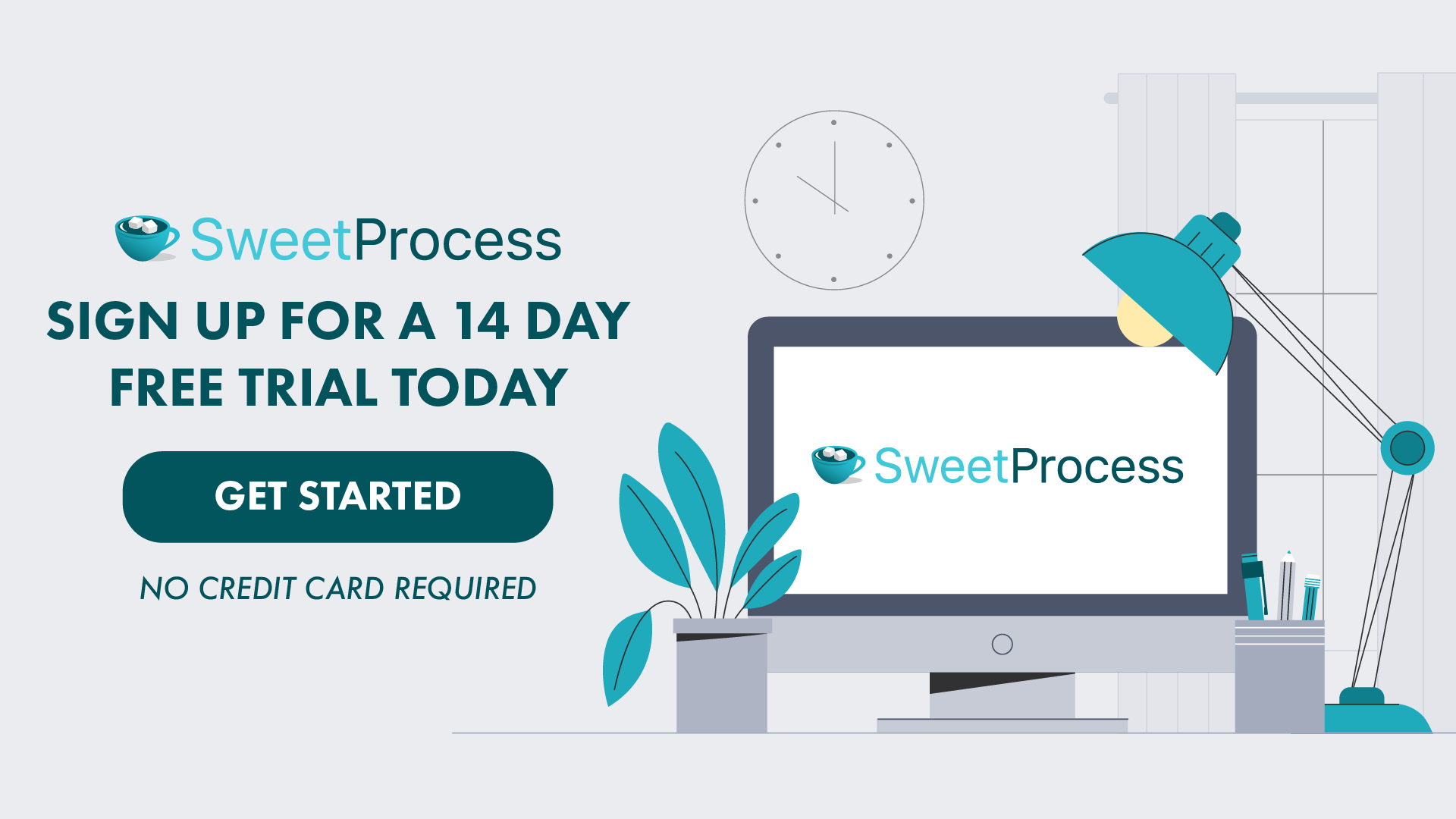Last Updated on April 25, 2025 by Owen McGab Enaohwo
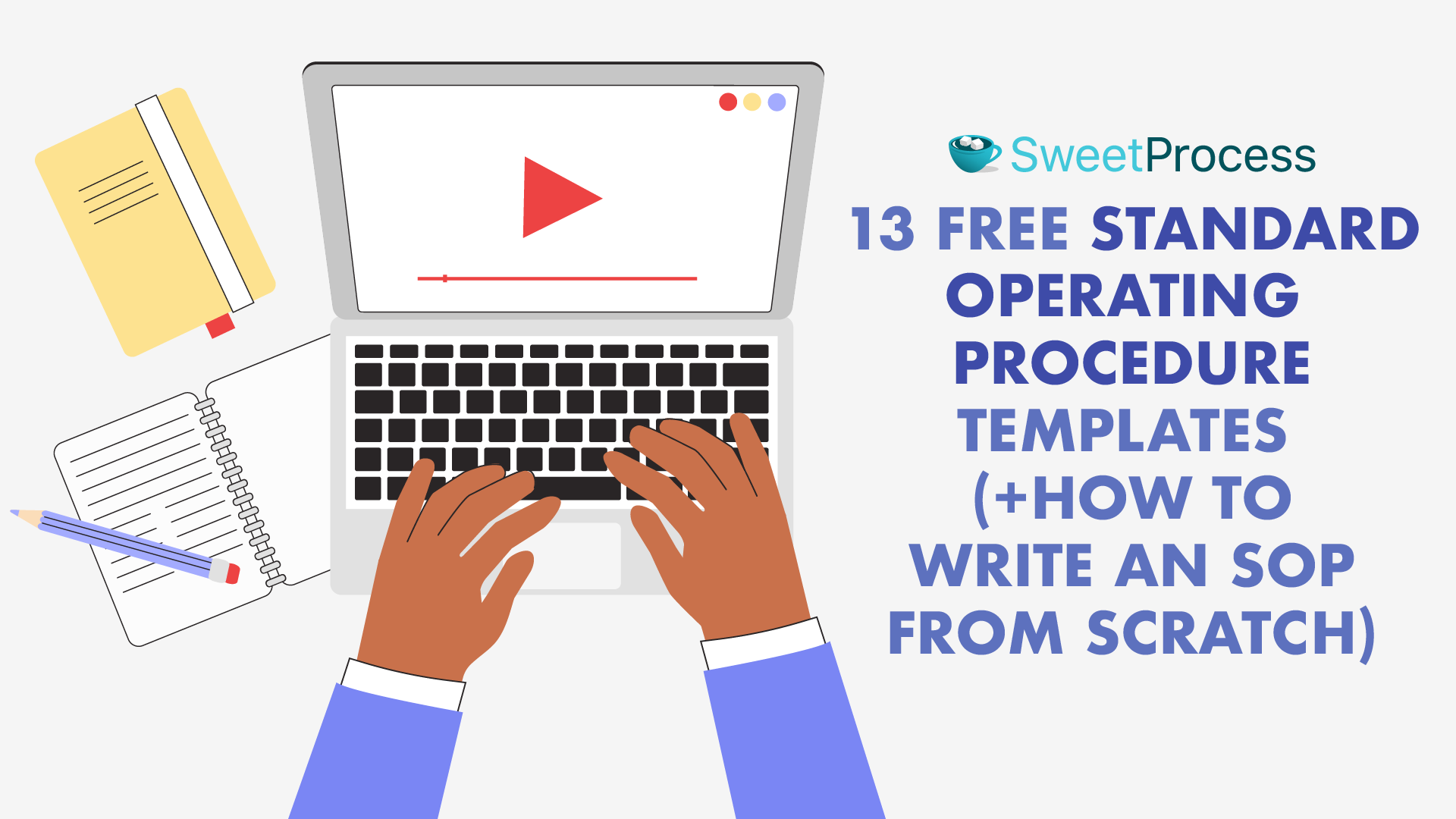
Struggling to maintain consistency and efficiency in your organizational processes?
Standard operating procedures (SOPs) are the backbone of any organized and successful operation—whether you’re managing a business, a team, or even your personal productivity.
Meanwhile, if you’re creating your SOPs from scratch, it may seem very challenging and time-consuming. That’s why we’ve got your back with these free, ready-to-use templates you can swipe.
Dive into this post for the 13 powerful standard operating procedure templates we’ve curated to save you time and ensure your workflows run like a well-oiled engine.
SweetProcess is an SOP tool for documenting your procedures, processes, and policies and sharing them with your team members. You can sign up for a free account and invite your team members to use all the features FOR FREE for 14 days.
What You’ll Learn in this Post
SOP Definition: What Does a Standard Operating Procedure Really Mean?
Benefits of Creating an SOP for Your Business
13 Free SOP Templates in Word, Google Docs, and PDF (For Founders and Managers)
How to Write an SOP From Scratch (A Step-by-Step Guide)
How to Create and Manage Your Company’s SOPs Using SweetProcess
Key Components of an SOP: What to Include in a Standard Operating Procedure
5 SOP Examples to Inspire Your Team
Standard Operating Procedure Formats and Types
Manage Your Business Operations Like a Pro Using SweetProcess
SOP Definition: What Does a Standard Operating Procedure Really Mean?
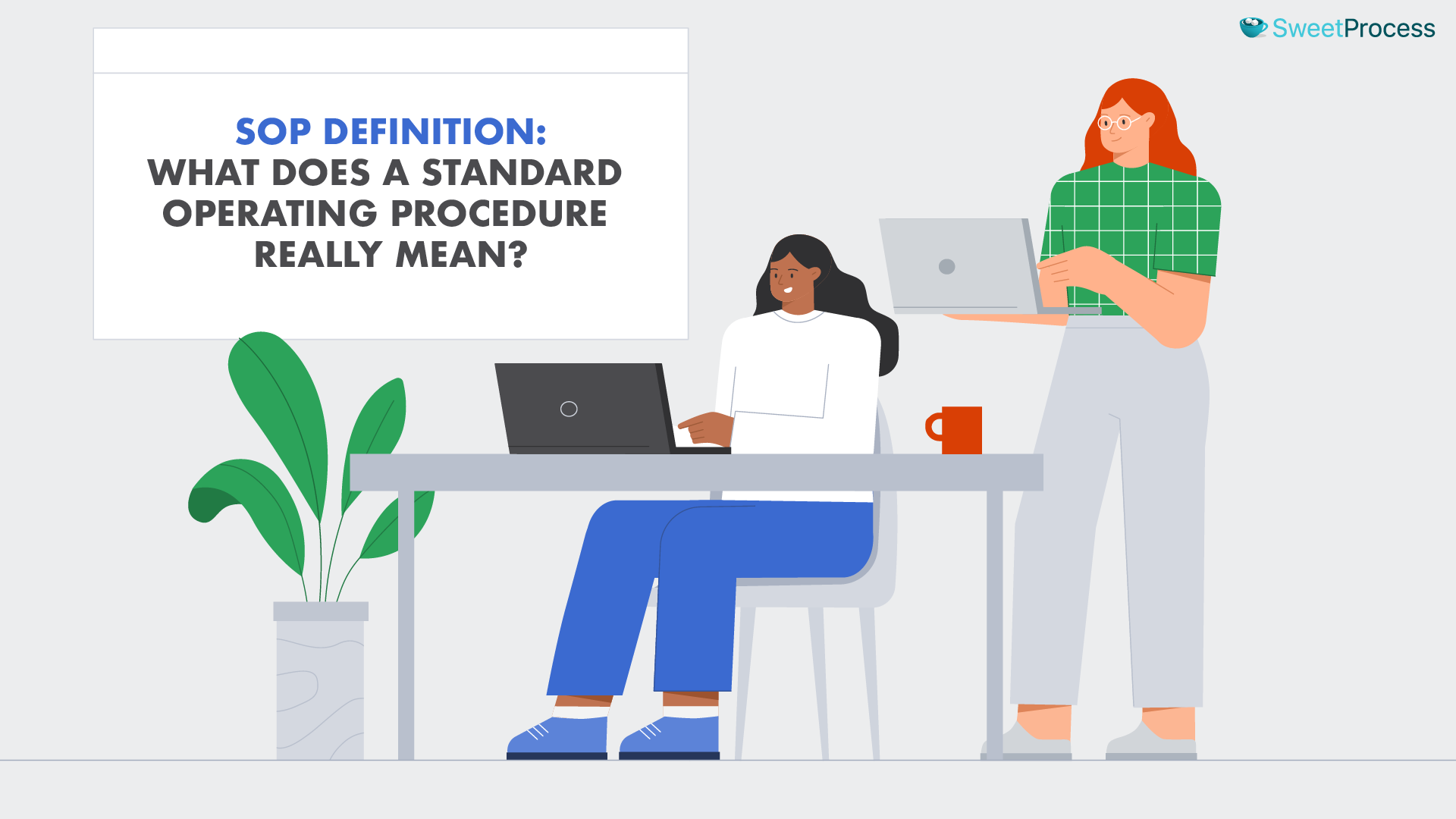
A standard operating procedure (SOP) is more than just a document—it’s the trade secret behind streamlined operations and consistent results in any productive organization.
By definition, an SOP is a set of step-by-step instructions that outline how to perform specific tasks or processes within an organization.
For onboarding new hires, handling customer inquiries, or managing complex workflows, SOPs help all team members attend to tasks like pros.
Think of an SOP as a clear roadmap to eliminate confusion, minimize errors, and ensure every team member is on the same page. A standard SOP is expected to communicate the following details to concerned team members:
- What to do
- When to do it
- Who should do it
- How to do it
- Materials and equipment needed
- Supervising team member
As the ultimate guidebook for running an efficient and effective operation, SOPs create a standardized approach that fosters collaboration, boosts productivity, and supports compliance.
Benefits of Creating an SOP for Your Business

Creating a standard operating procedure (SOP) helps you document tasks and builds a foundation for consistent and efficient operations. Below are other benefits of creating an SOP for your company.
Helps Employees to Be Accountable
SOPs clearly outline roles, responsibilities, and expectations for every task. The detailed instructions provided in SOPs will help each employee know exactly what they need to do and how to do it, making it easier to hold themselves and others accountable for their performance. This is especially crucial in client management, where clear procedures ensure seamless communication and service delivery.
Leads to Compliance With Industry Regulations
Some industries require strict adherence to regulatory standards. Detailed SOPs will help ensure that your team consistently follows these rules, reducing the risk of non-compliance penalties and enhancing your organization’s credibility.
Standardizes Your Business Processes
Inconsistent processes can lead to frequent errors and inefficiencies. Implementing SOP best practices ensures that workflows are consistent, regardless of who performs the tasks or their experience level. Consistency is crucial for your company’s scalability and long-term success, even if different team members with different levels of experience handle tasks.
Facilitates Quality Control Across the Board
SOPs help to maintain the quality of your products or services by documenting best practices and standards. They act as a benchmark, and you can quickly identify and address any deviations when inconsistencies occur.
Enhances Employee Onboarding and Training
Comprehensive SOPs make training new employees easy. Instead of relying solely on verbal instructions, you can provide clear, written guidelines that help new hires quickly adapt to their roles and contribute to the team’s success.
Reduces Time Waste
SOPs provide clear, step-by-step instructions. Every team member needs this to eliminate guesswork and reduce the time spent figuring out how to complete tasks. This streamlined approach boosts overall efficiency and productivity.
Supports Business Continuity
SOPs act as a knowledge repository, allowing tasks to be completed even when key team members are unavailable. This documentation is enough to make the business run smoothly, even when business ownership is transferred or under any circumstances.
Improves Communication and Collaboration
SOPs have clearly defined roles and responsibilities that enhance coordination among team members. Pairing them with an organizational chart further clarifies reporting structures, making it easier for employees to understand their roles and work together effectively. This facilitates collaboration and reduces miscommunication and misunderstandings.
Encourages Continuous Improvement
Documented processes can be regularly reviewed and updated. This will foster a culture of innovation and ongoing improvement within the organization.
Strengthens Customer Confidence
When your business operates with documented consistency, it reflects in your products and services. Consistently delivering quality service to your customers will build trust and satisfaction.
With these benefits in mind, it’s clear that creating SOPs isn’t just about documentation—it’s about building a foundation for growth, consistency, and operational excellence in your business.
13 Free SOP Templates in Word, Google Docs, and PDF (For Founders and Managers)

Having a structured approach is non-negotiable when managing a growing business. This is why you need SOP templates that are easily customizable to fit your needs.
Writing an SOP from scratch will take a lot of time. Swiping these SOP templates will, therefore, enable you to invest your time in other important business areas.
Here are 13 must-have templates designed to streamline your operations. They are available in Word, Google Docs, and Excel formats:
1) IT SOP Template
You will always need a step-by-step guide to manage IT processes. Processes like troubleshooting, software updates, and cybersecurity protocols must be standardized. An IT SOP is perfect for keeping your tech team aligned and proactive.
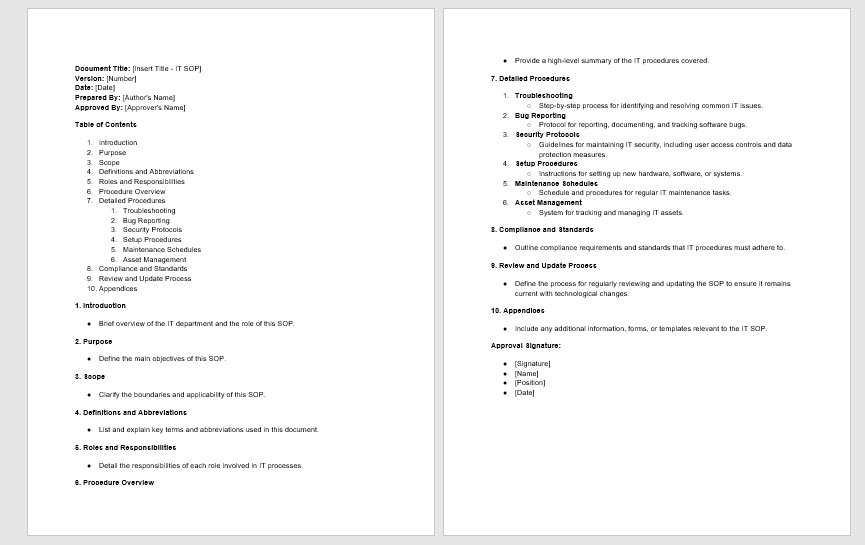
2) Warehouse SOP Template
Streamline inventory management, order fulfillment, and safety checks with this warehouse-specific template. It is designed to ensure efficiency and reduce errors.
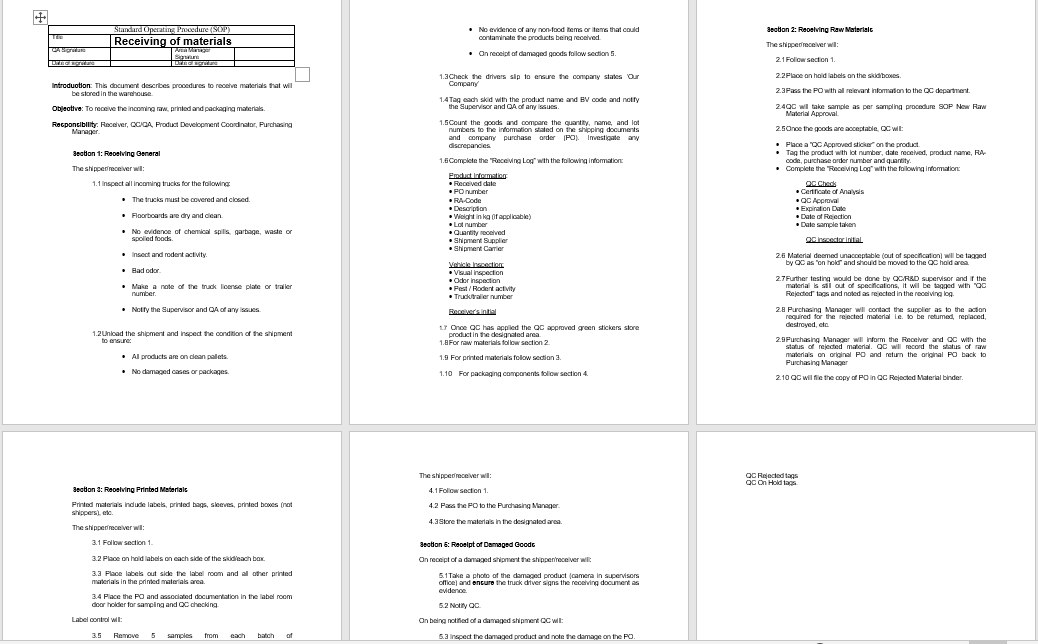
Download the Warehouse SOP Template
3) Sales SOP Template
This sales SOP template will help you define your sales strategies and workflows, from lead generation to closing deals. It will also help standardize customer interactions and boost revenue.
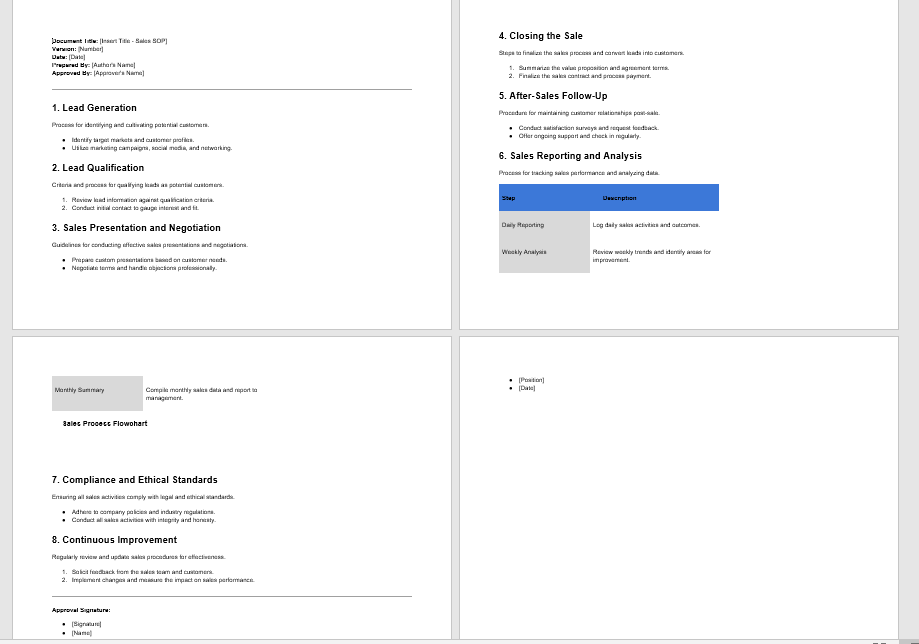
Download the Sales SOP Template
4) HR SOP Template
Hiring, onboarding, and employee relations management are important HR tasks. This template ensures HR processes are consistent, compliant, and employee-focused.
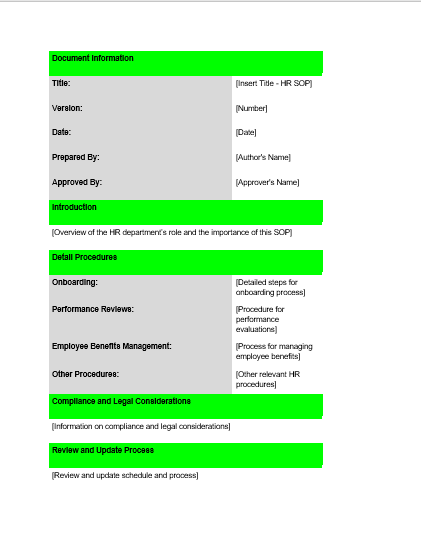
5) Manufacturing SOP Template
A detailed manufacturing Standard Operating Procedure template can ensure quality and efficiency in your production line. It is also great for minimizing waste and maintaining product standards.
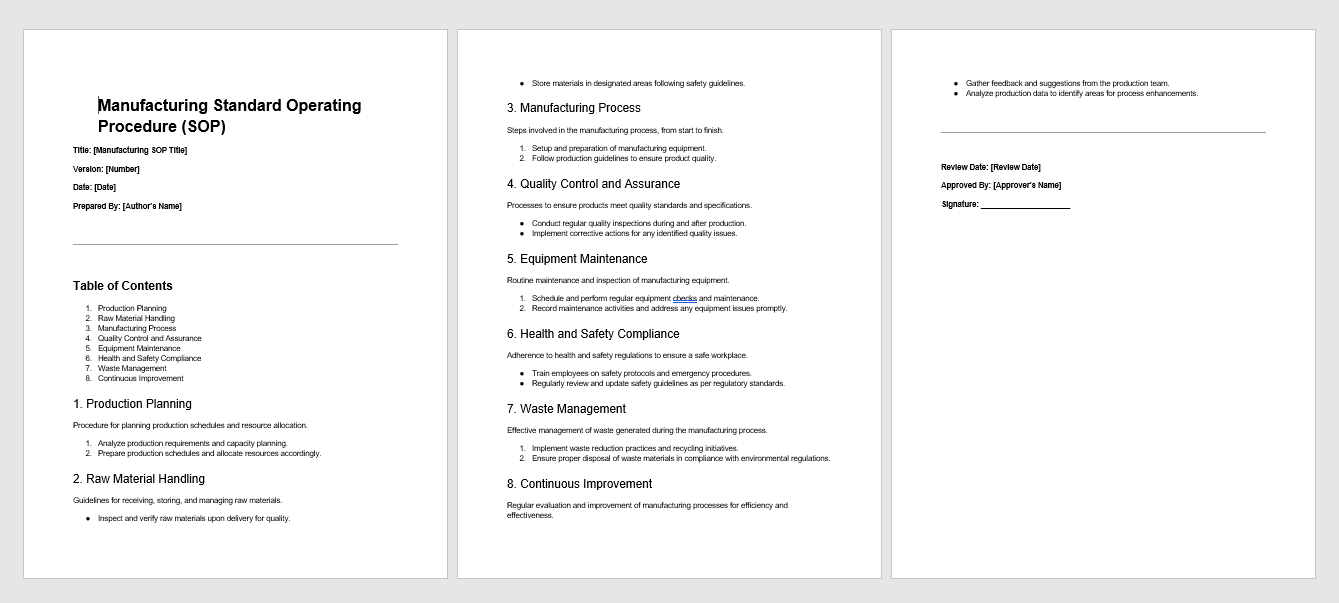
Download the Manufacturing SOP Template
6) Accounting SOP Template
An accounting SOP template will help to simplify your financial processes, from expense tracking to monthly reporting. It is a vital tool for maintaining accuracy and compliance in your books.
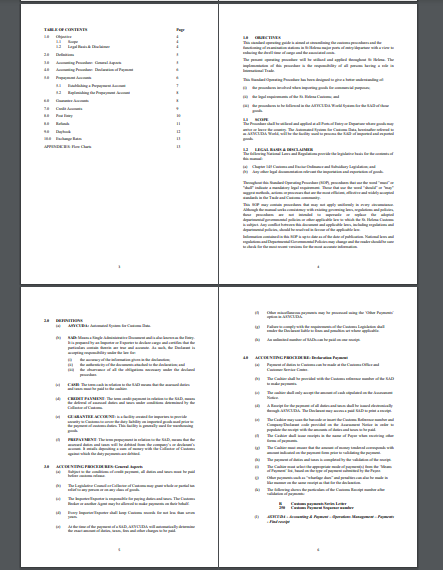
Download the Accounting SOP Template
7) Training SOP Template
The training Standard Operating Procedure template ensures all employees receive consistent instruction, regardless of who the trainer is. You can use a training SOP to create structured training programs for your team.
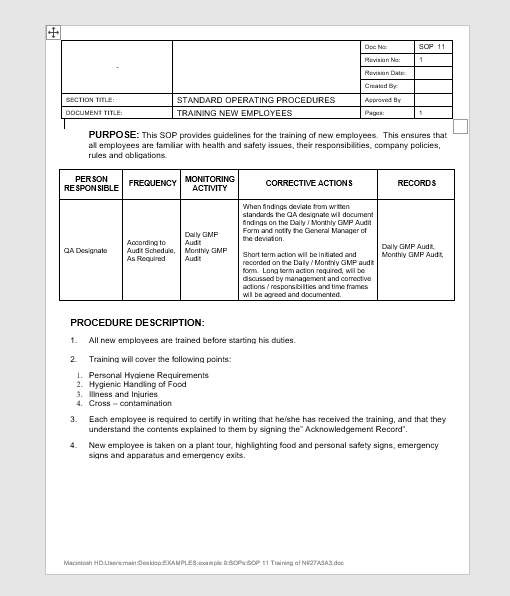
Download the Training SOP Template
8) Admin SOP Template
The admin SOP template is designed for seamless office operations. It is an easy way to centralize administrative tasks, such as document management and meeting scheduling.
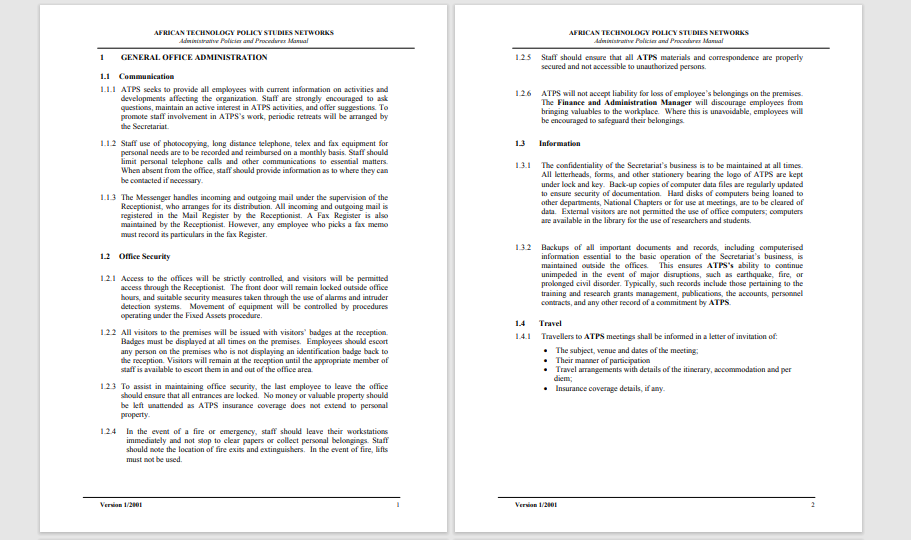
Download the Admin SOP Template
9) Restaurant SOP Template
It’s important to keep your kitchen and restaurant staff operations running smoothly. This template is ideal for maintaining food prep, service quality, and hygiene consistency.
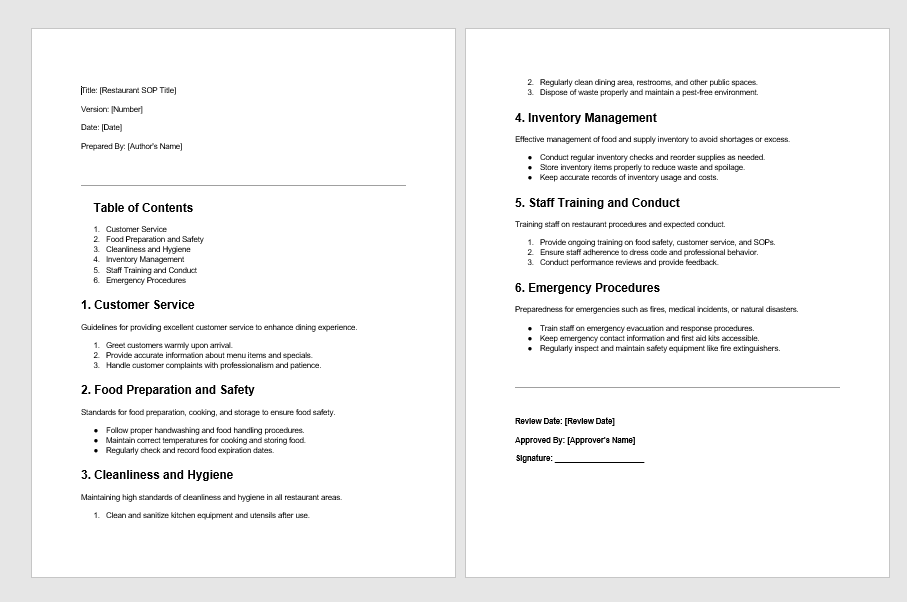
Download the Restaurant SOP Template
10) Internal Communication SOP Template
Great internal communication practices define how your team shares information, from email protocols to meeting guidelines. This template will help to foster better collaboration and commitment.
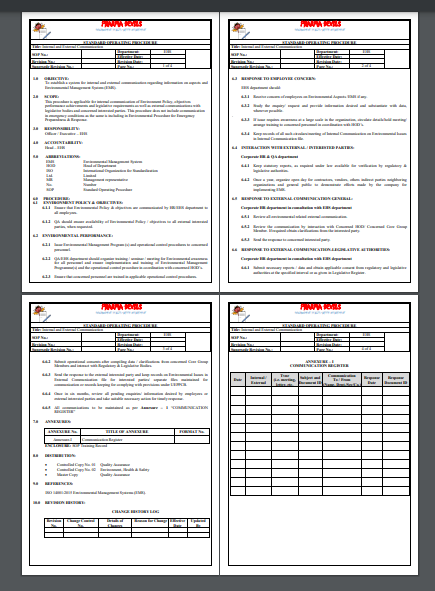
Download the Internal Communications SOP Template
11) Inventory SOP Template
Keeping inventory requires stock management, reordering, and audits. This template helps ensure perfect retail and warehouse operations.
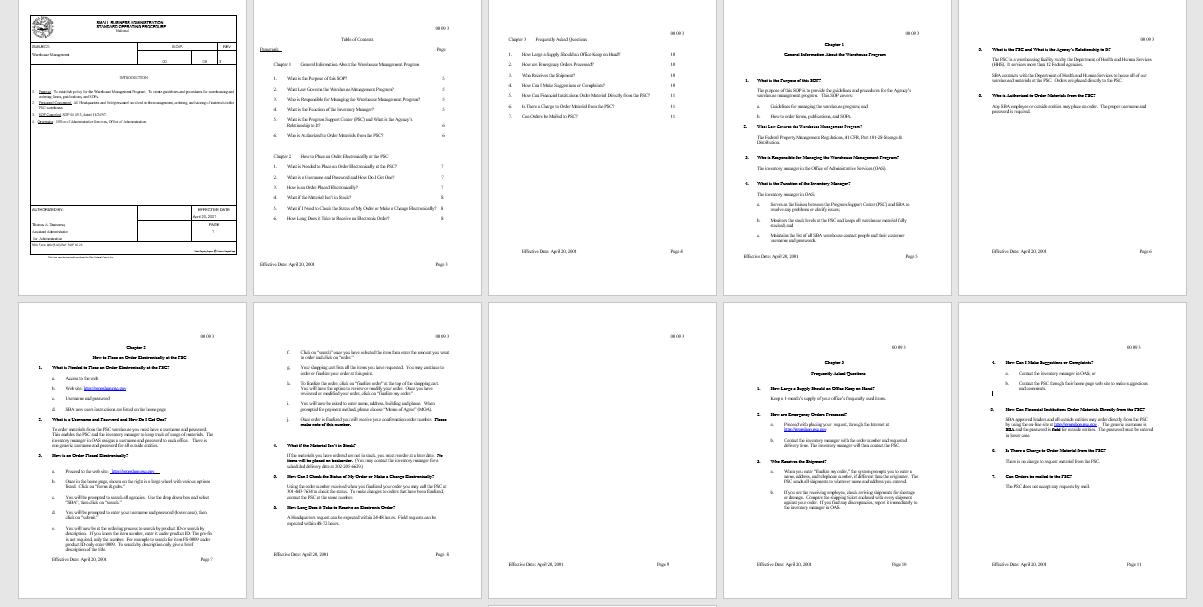
Download the Inventory SOP Template
12) Accounts Payable SOP Template
Keeping track of vendor payments, approvals, and reconciliation requires a detailed account payable SOP. This template is a must-have for smooth financial management.
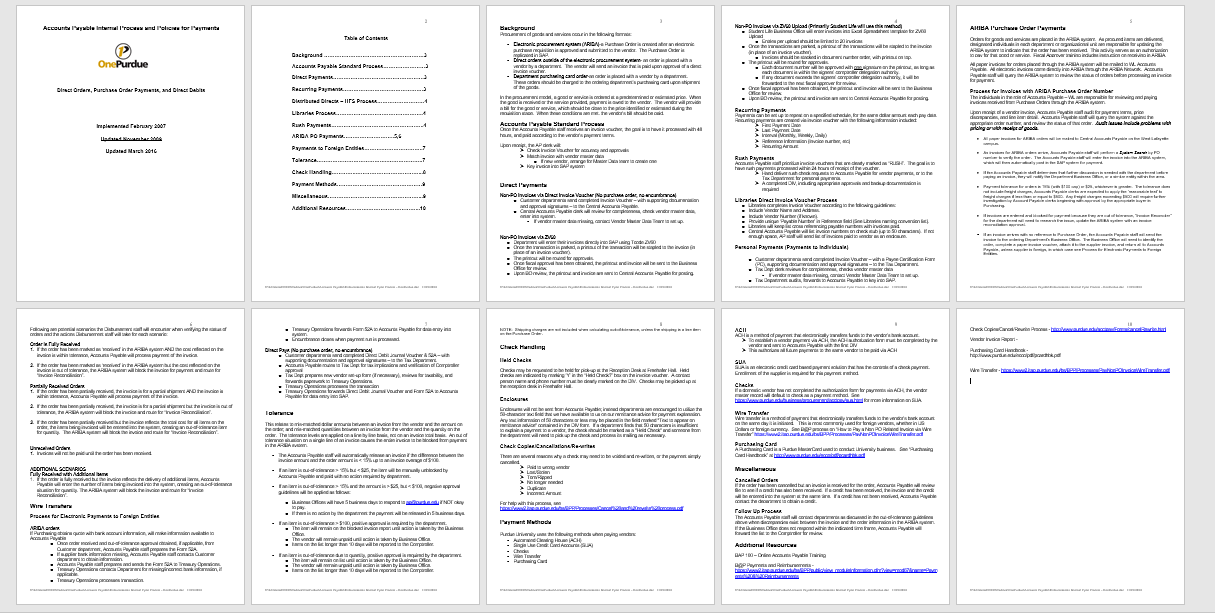
Download the Accounts Payable SOP Template
13) Procurement SOP Template
The procurement Standard Operating Procedure template will help the procurement team standardize the procurement process, from supplier selection to purchase order approvals. This template ensures cost efficiency and supplier accountability.
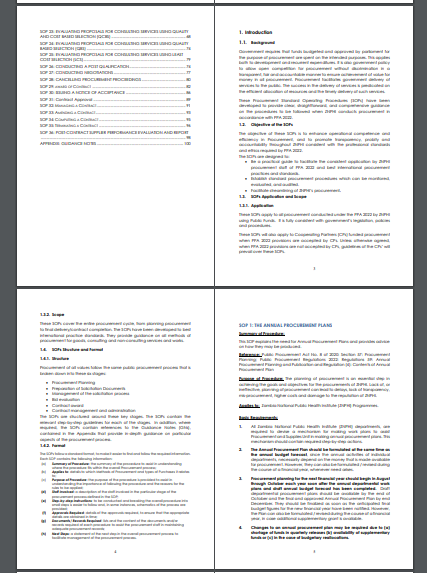
Download the Procurement SOP Template
Whether you’re managing IT, HR, or inventory, a free SOP template is here to help you work smarter. These 13 templates are your shortcut to efficiency, consistency, and peace of mind.
How to Write an SOP From Scratch (A Step-by-Step Guide)

Gone are the days when you must structure every SOP aspect from scratch.
Today, you’re presented with different options that take the stress off your shoulders.
All the time-consuming parts of your SOP creation can be handled easily, from editing a template to fit your needs to writing your SOP with AI.
However, if you still want to write your SOP from scratch, it will be helpful to break it into clear, actionable steps to simplify the process.
Follow these 12 steps to craft an effective SOP:
Step 1: Define Your Goal
The starting point of your SOP creation process is to clarify the purpose of the SOP. What problem will it solve? What process or task will it standardize? A clear goal helps focus your efforts.
Step 2: Define the Scope of the SOP
It’s important to determine the boundaries of the SOP. Which tasks or processes will it cover? Which departments will it serve? Specifying the scope of your SOP will ensure relevance and avoid unnecessary complexity.
Step 3: Choose Your Preferred Format
Decide how you want to structure the SOP. Will it be a checklist, a flowchart, or a step-by-step guide? Your format should align with the task’s complexity and your team members’ needs.
Step 4: Determine the Stakeholders and Creators
Identify who will be involved in developing and using the SOP. Engaging stakeholders early will help ensure the SOP meets their needs.
Step 5: Gather All Your Information
Collect all the data, resources, and input required to complete the SOP. This could include existing documentation, expert advice, and process walkthroughs.
Step 6: Identify Your Audience
Consider who will use the SOP and tailor it to their level of expertise. For beginners, use simple language; for advanced users, use technical vocabulary.
Step 7: Create the SOP Outline
To create an SOP outline, it’s important to draft a structure that includes all the necessary sections, such as purpose, scope, responsibilities, tools, step-by-step instructions, and troubleshooting tips. Reviewing SOP examples can help you understand how to format these sections effectively and ensure your document is clear and actionable.
Step 8: Flesh Out the Outline
Now is the time to fill in the details for each section of the outline. Be precise, concise, and logical to ensure each step is easy to follow. Use visuals like diagrams, screenshots, or videos where necessary.
Step 9: Review Your SOP
Have stakeholders review the SOP for clarity, accuracy, and completeness. Incorporate feedback to review and perfect the document.
Step 10: Train Your End User
Introduce the SOP to the team, along with the necessary training. Walk them through the document and address any questions or concerns.
Step 11: Test and Adjust the SOP in Practice
Implement the SOP in a practical scenario to see how it works. Note any gaps or inefficiencies and revise as needed.
Step 12: Update Regularly
Processes evolve, making it necessary to review and update your SOP regularly to keep it relevant and effective.
By following these steps, you can create a clear and practical SOP, which will be a valuable tool for your team’s success.
How to Create and Manage Your Company’s SOPs Using SweetProcess

SweetProcess is a process documentation tool that makes it easy to manage all your processes and collaborate with your team in one place.
With a SweetProcess account, you can create standard operating procedures, processes, and policies. Beyond all these, you can also collaborate on your documents, assign tasks to team members, and create and manage a knowledge base, among other features.
The step-by-step process of creating an SOP is described in this section.
How to Create an SOP Using SweetProcess
Log in to your SweetProcess account or create a new account for free.
Click on “Create Procedure.”

Write the title of the procedure.

Select the team that should access the procedure.

Click “Write with SweetAI” if you want your procedure written by our SweetAI.

If you want to write your own procedure from scratch, click “Continue” and input all the necessary details.

Managing Your SOP on SweetProcess
When you have your SOP in your SweetProcess account, some of the recommended practices required that can help you manage your SOPs are:
View Version Histories
If you want to view the previous versions of your SOP document, follow the detailed steps below:
Log in to your SweetProcess account.
Click on “More” and go to “Procedures.”
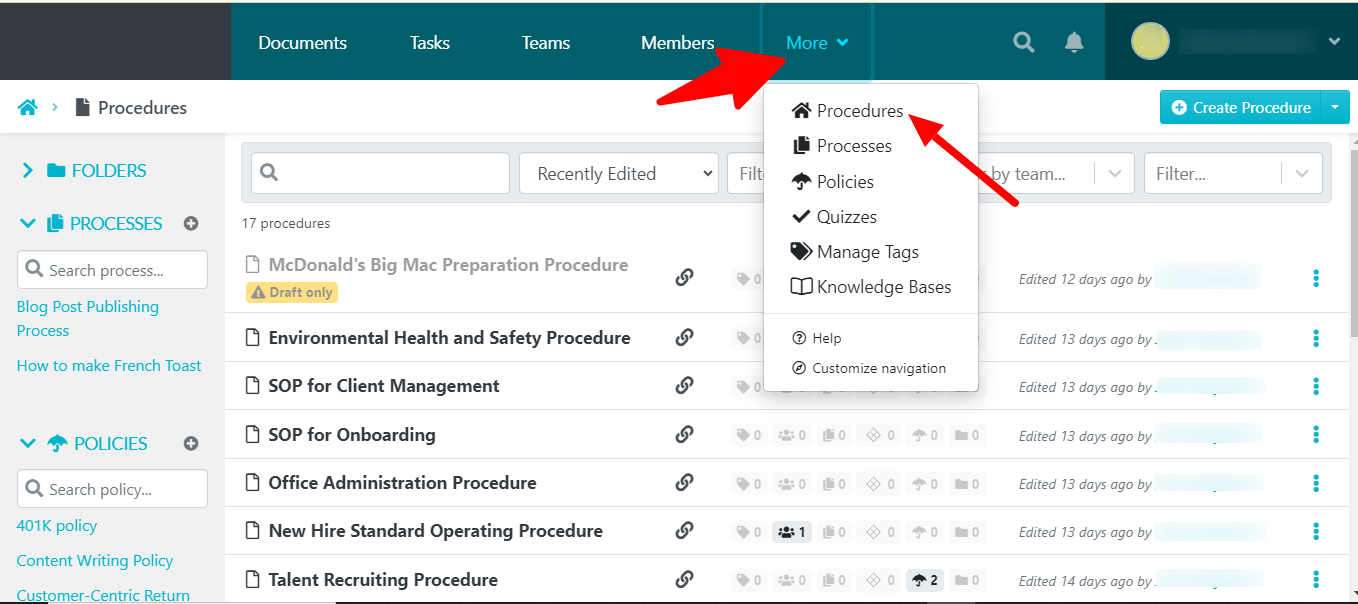
Open the procedure of the version history you want to view.
Click on the clock icon on the left part of the screen.
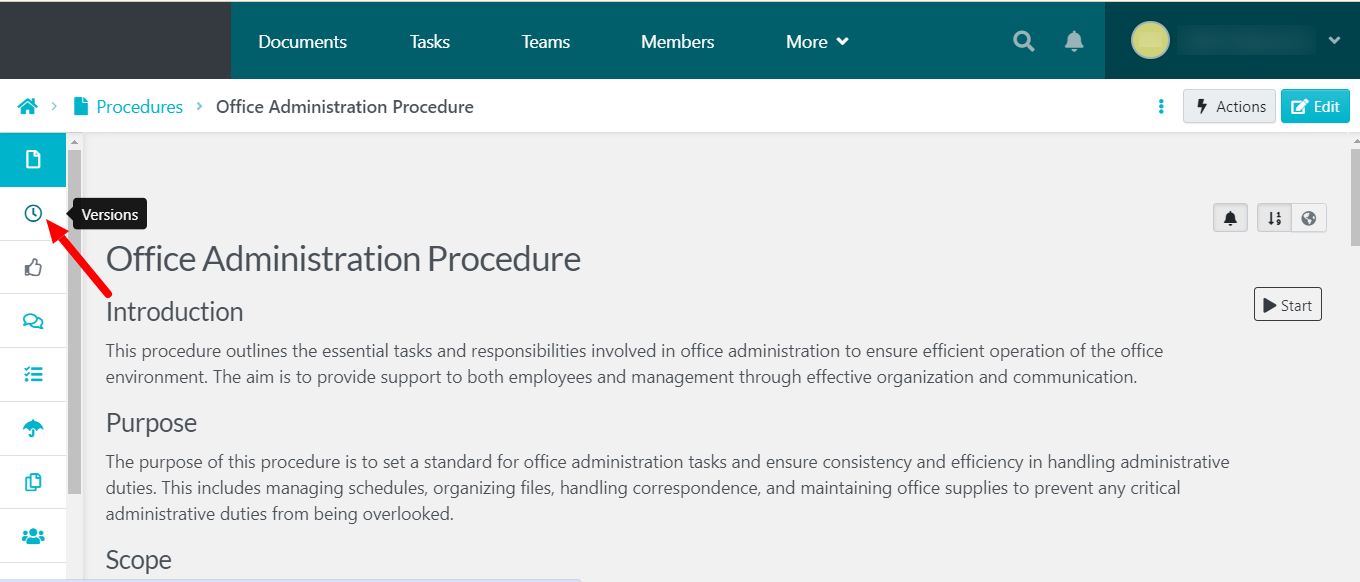
You will be able to view the different versions of the SOP document to compare the changes.
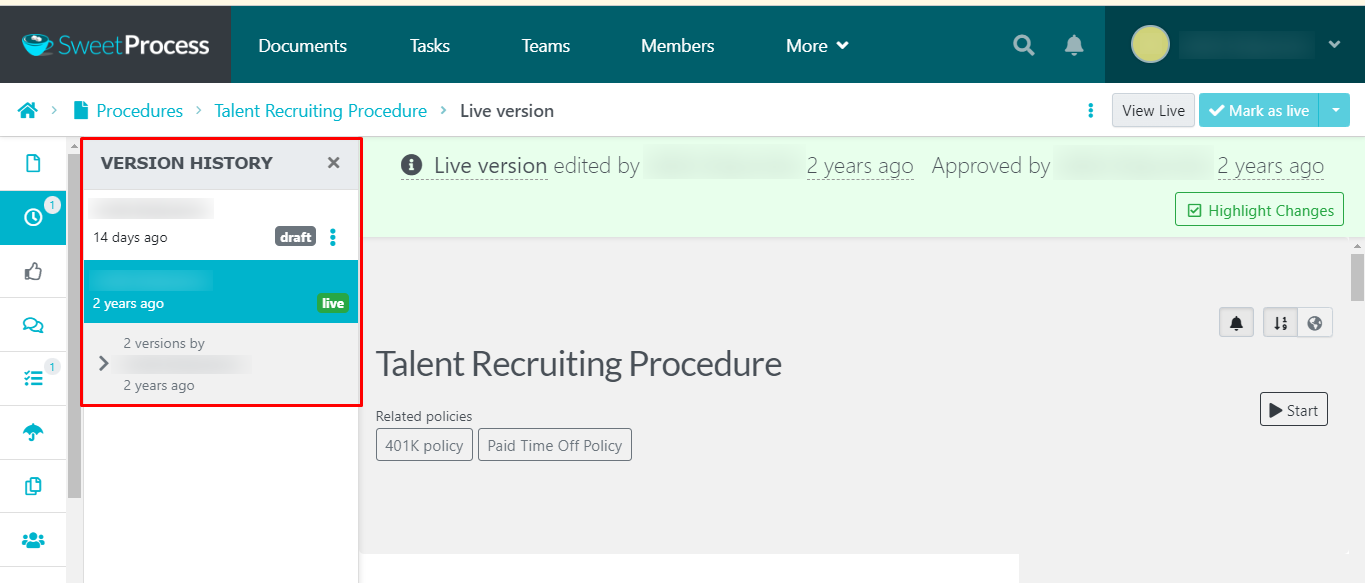
Collaborate on Your SOPs
SweetProcess comes with a commenting feature that allows all team members to collaborate easily on your team’s SOPs. You can comment on the procedure to share your thoughts in real-time without relying on another communication tool.
To comment on a particular procedure, open the document and use the comment icon on the left side of your screen.
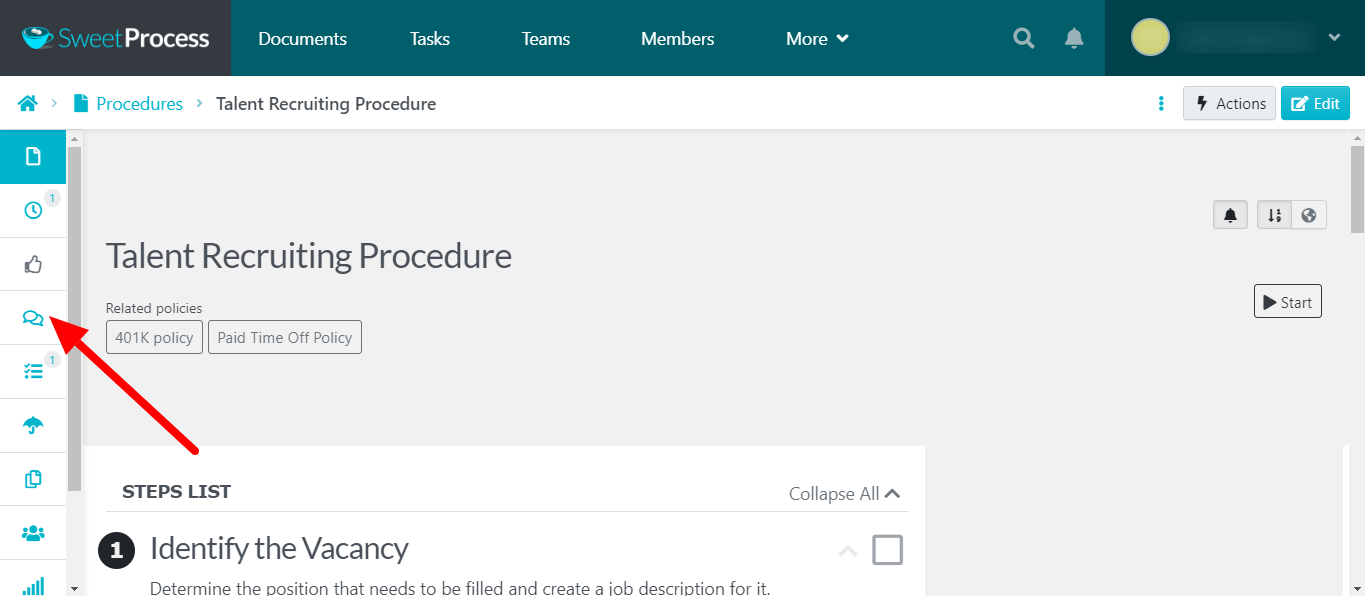
Assign Procedures as Tasks
Once you have a procedure written in SweetProcess, you can assign it as a task whenever you need a team member to attend to it.
For example, a “New Hire Onboarding” SOP will be assigned to every new team member who joins the organization while maintaining original ownership of the SOP.
To assign a process as a task:
Log in to your SweetProcess account.

Open the procedure you want to assign.
Click “Actions” at the top right corner of the screen.
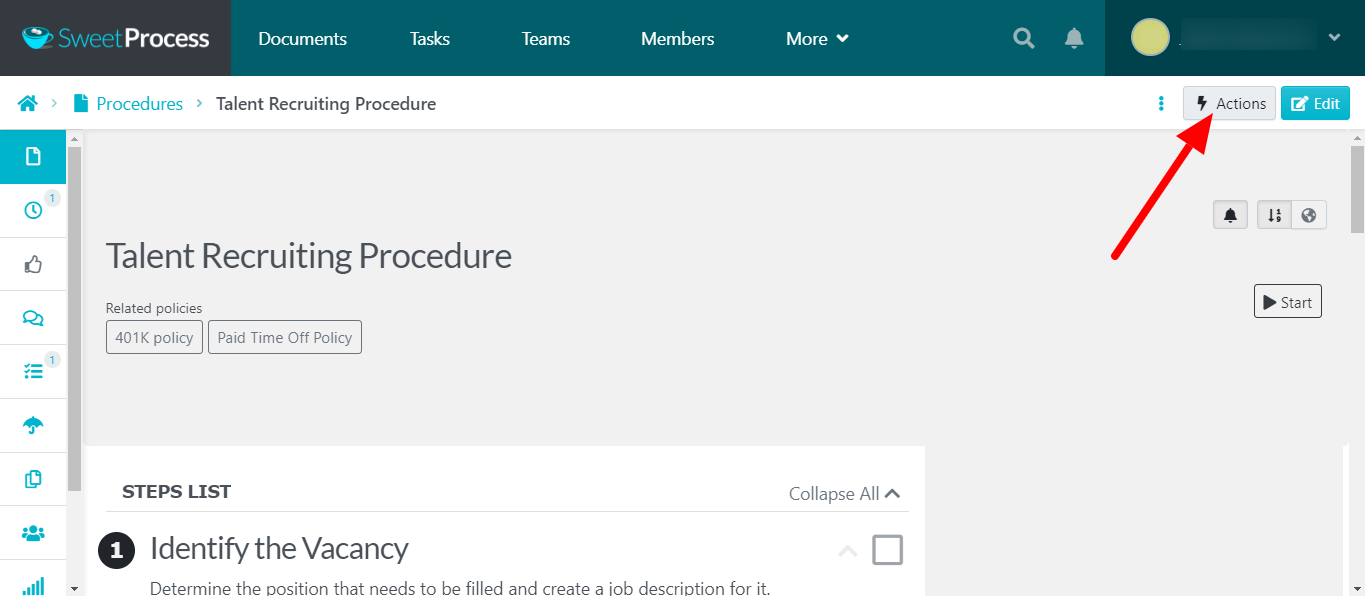
On the drop-down menu, select “Assign as Task.”
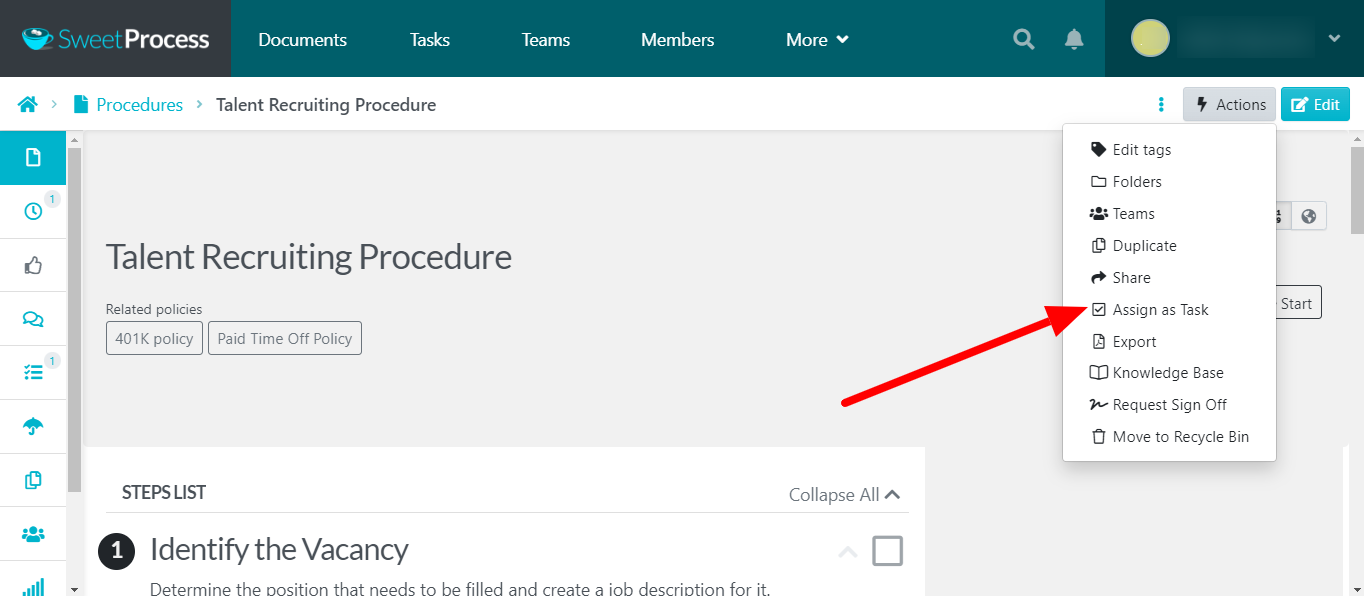
Attach Policies to Procedure
If you have to remind your team members of rules and regulations in a particular procedure, the best bet is to have them written as policies. You can attach your desired policy(ies) to your procedure with just a few clicks.
Once the procedure is open, click on the umbrella icon on the left side of your dashboard.
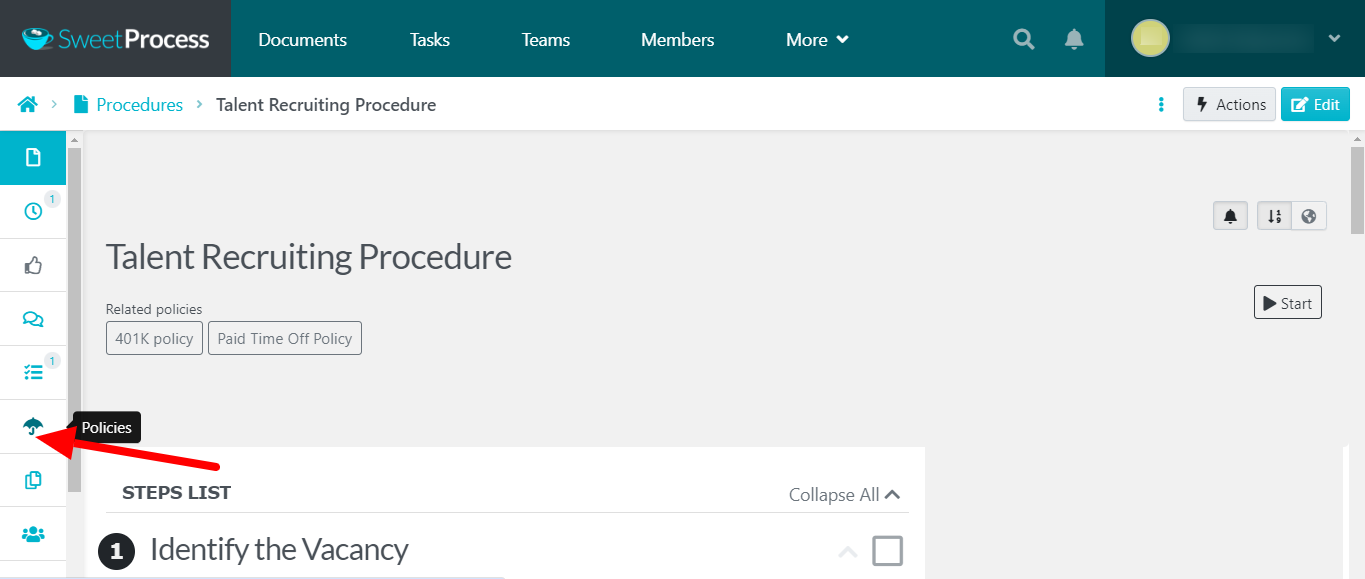
Select the policy(ies) you want to attach to your procedure.
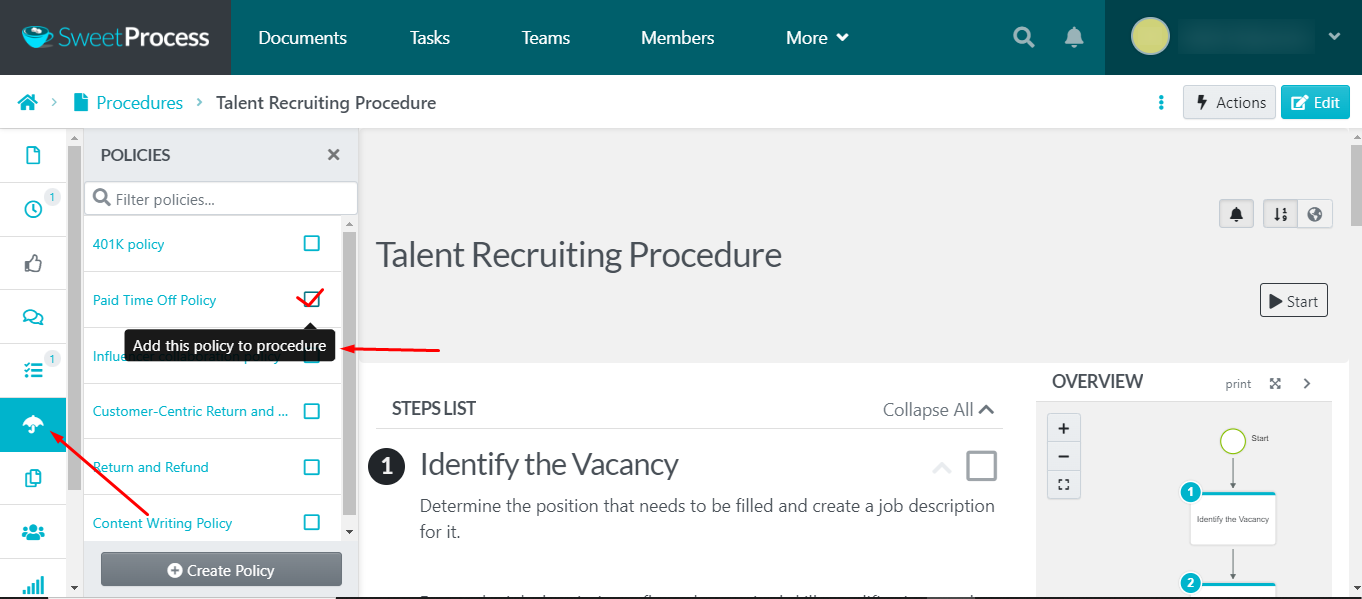
You will see a notification once the policy is attached.
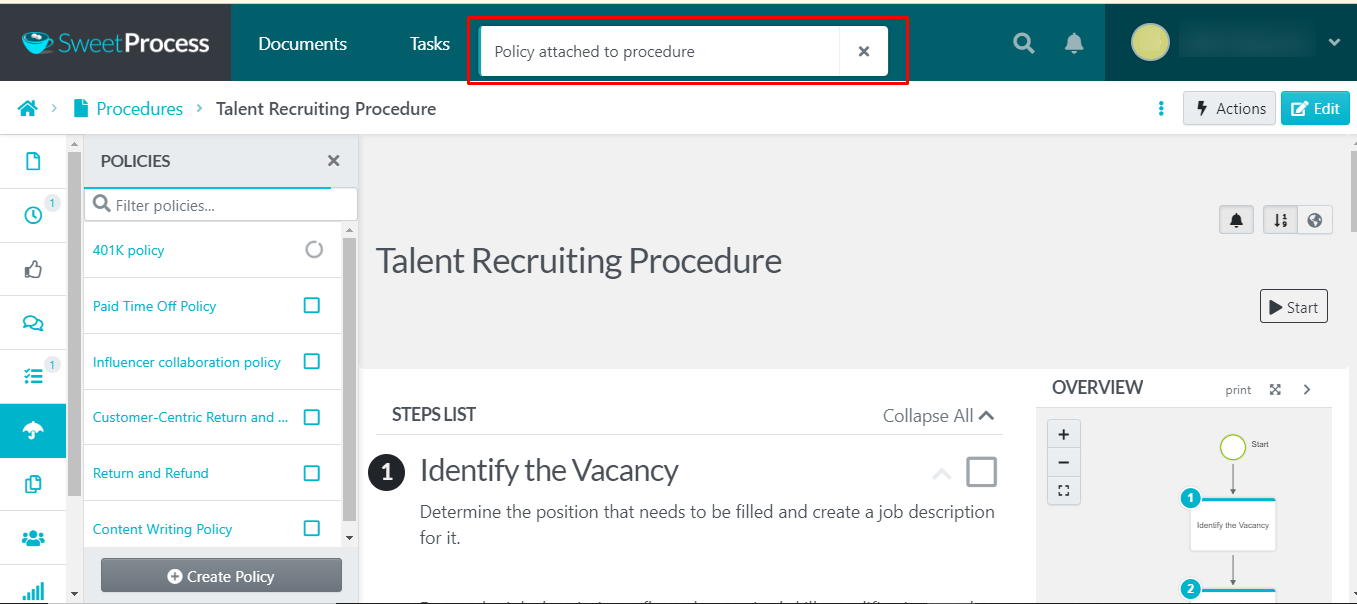
View Procedure Activity
SweetProcess lets you see all your team members’ activities and your procedures. It tells you who created, approved, viewed, or reviewed your procedures. This is a way to gain back-end insight into how your team works with each procedure.
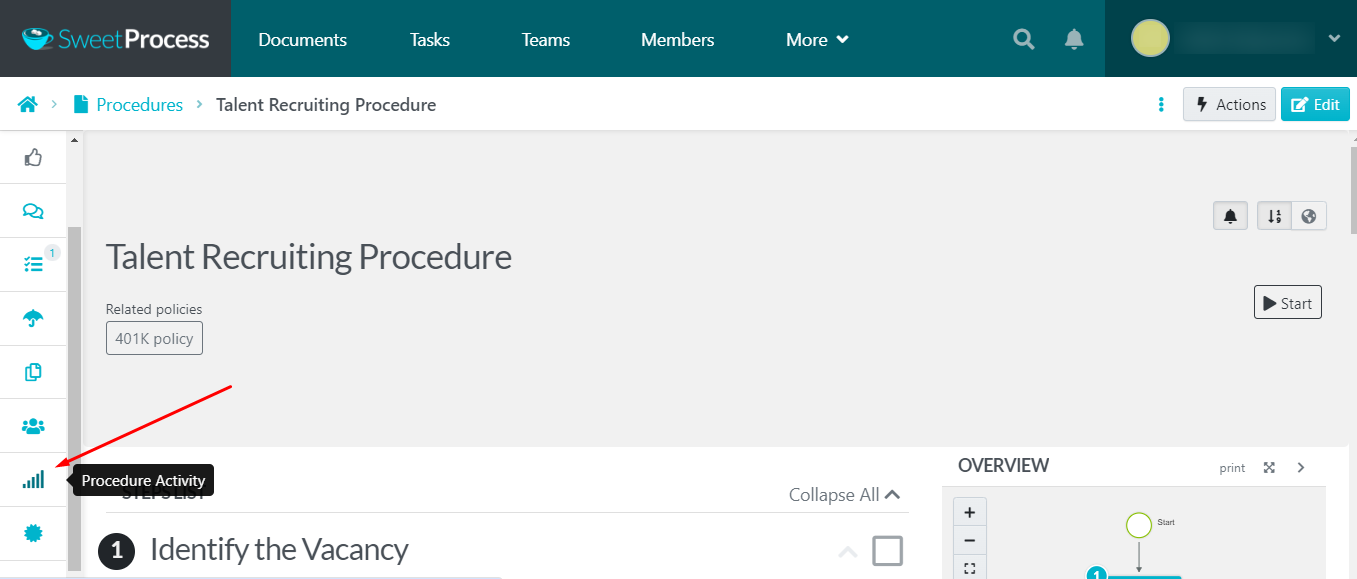
And you can view the activity on the next interface.
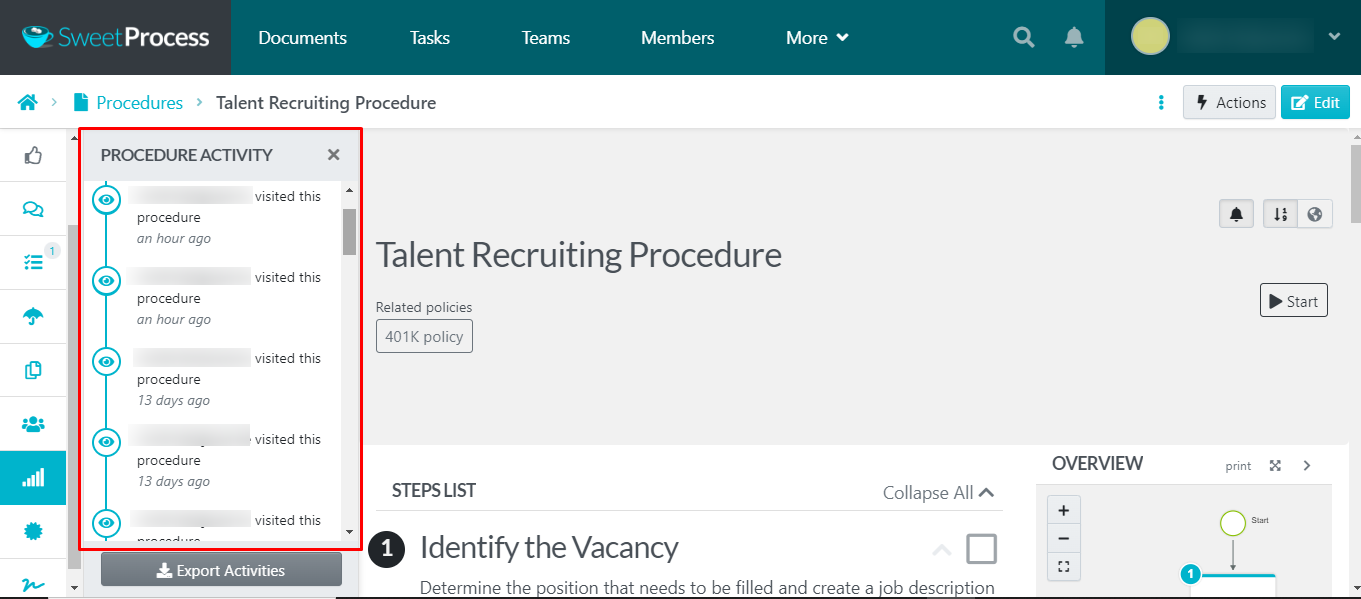
Review SOPs
Changing regulations within the company and industry will require you to review your procedures from time to time.
SweetProcess has a feature that makes it easy for you to schedule your SOP reviews.
To enable procedure review, click the “Review” icon on the left side of your dashboard.
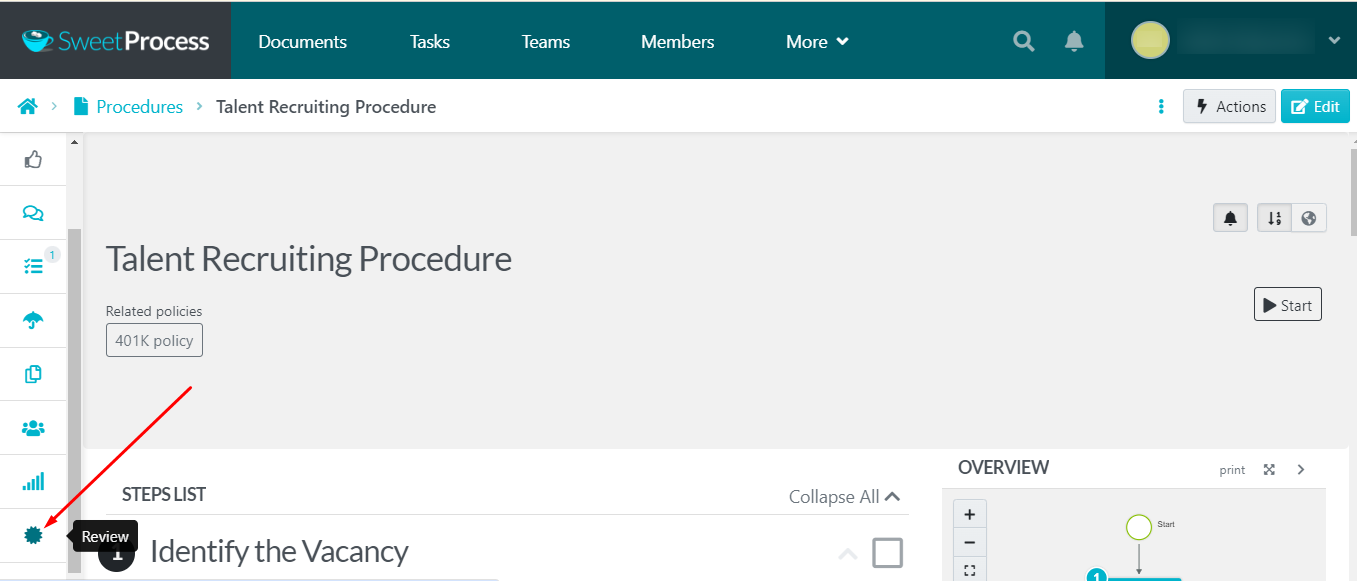
Click on “Enable.”
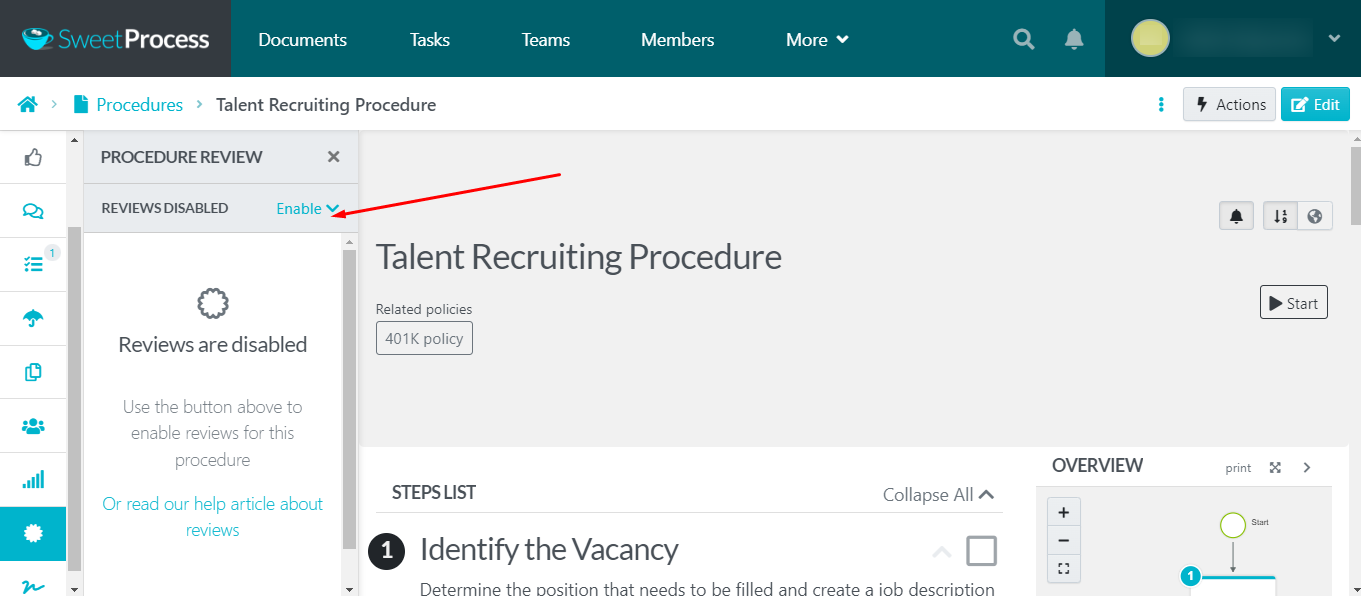
On the next interface, assign the team member, review date, and review interval for your procedure.
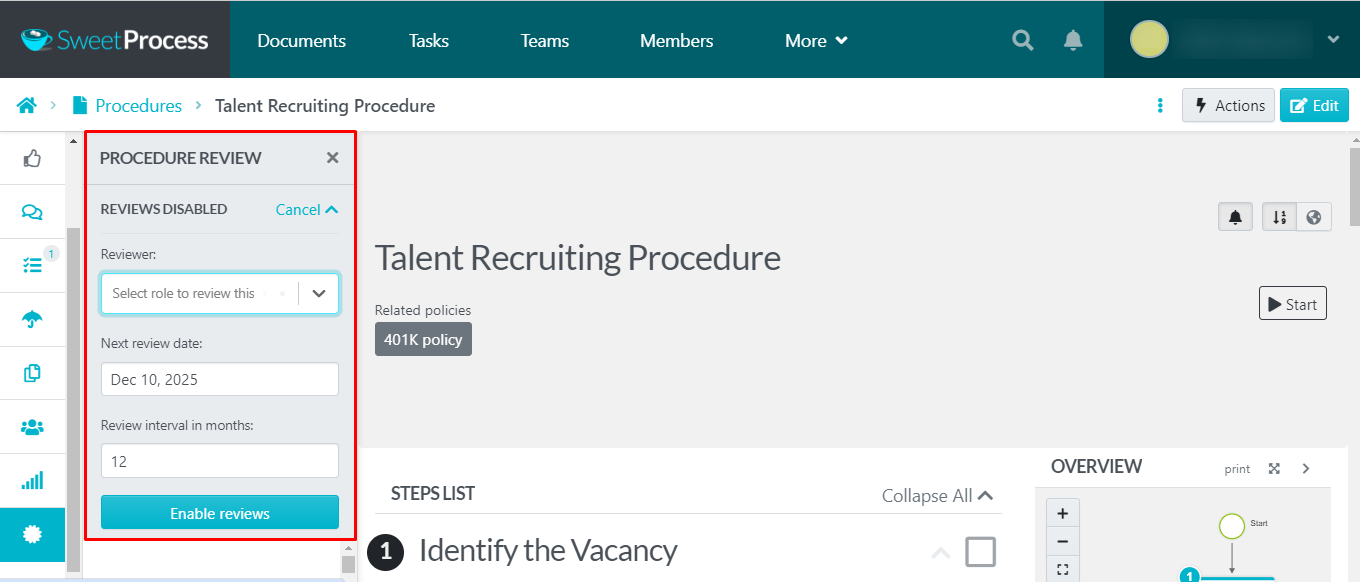
Request Sign-off on Procedure
If you want to ensure that all concerned team members are aware of any procedure to work with, you should ask the team to append their signature to the procedure.
To request team members’ sign-off on a procedure, click on the signature icon on the left side of the dashboard.
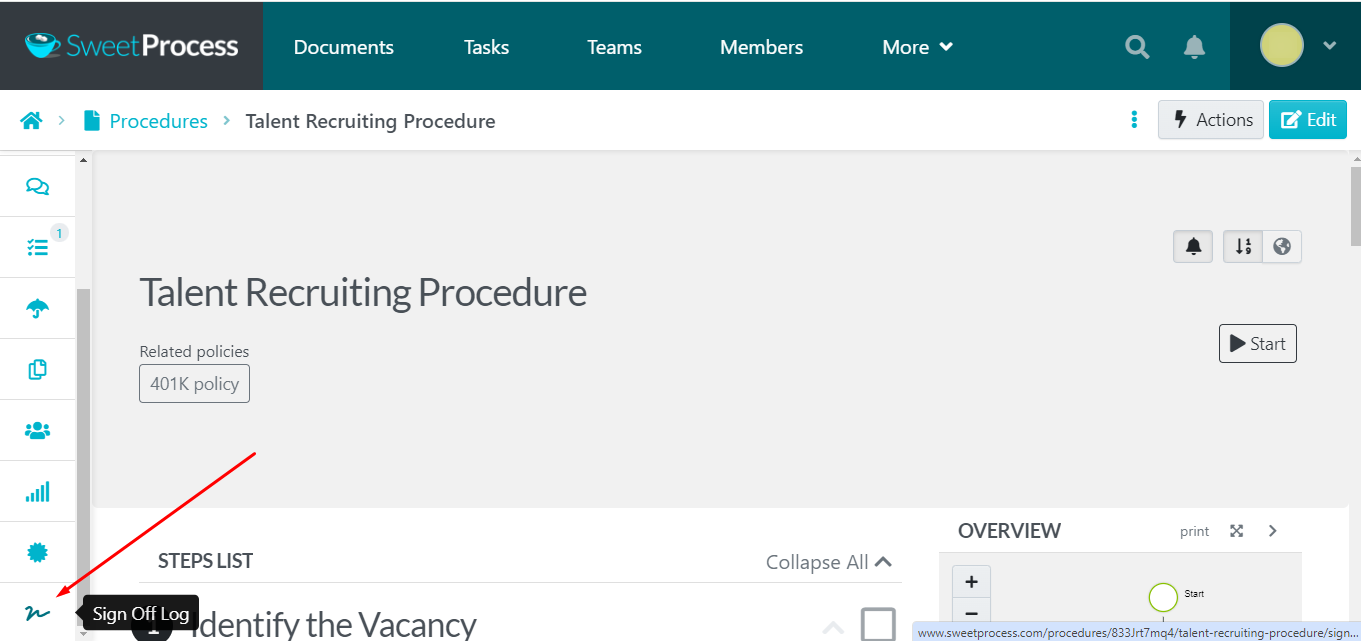
Click on “Request Sign Off.”
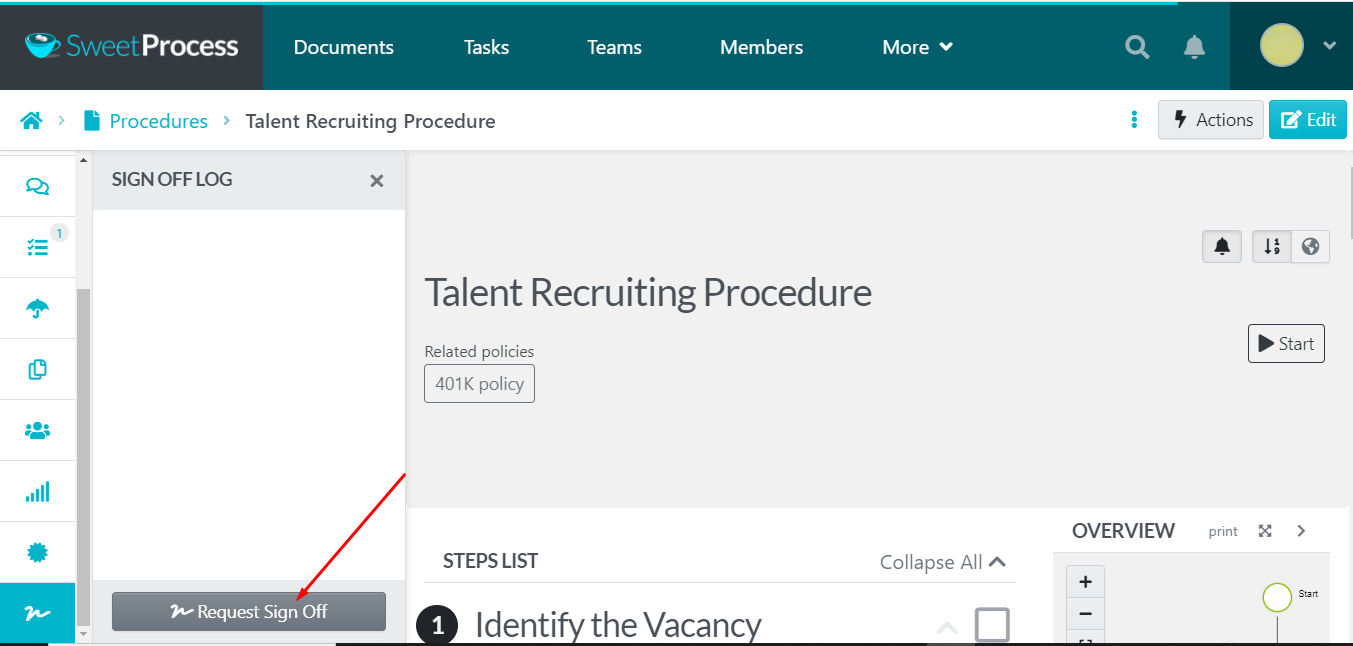
Confirm your action by clicking on “Request Sign Off.”
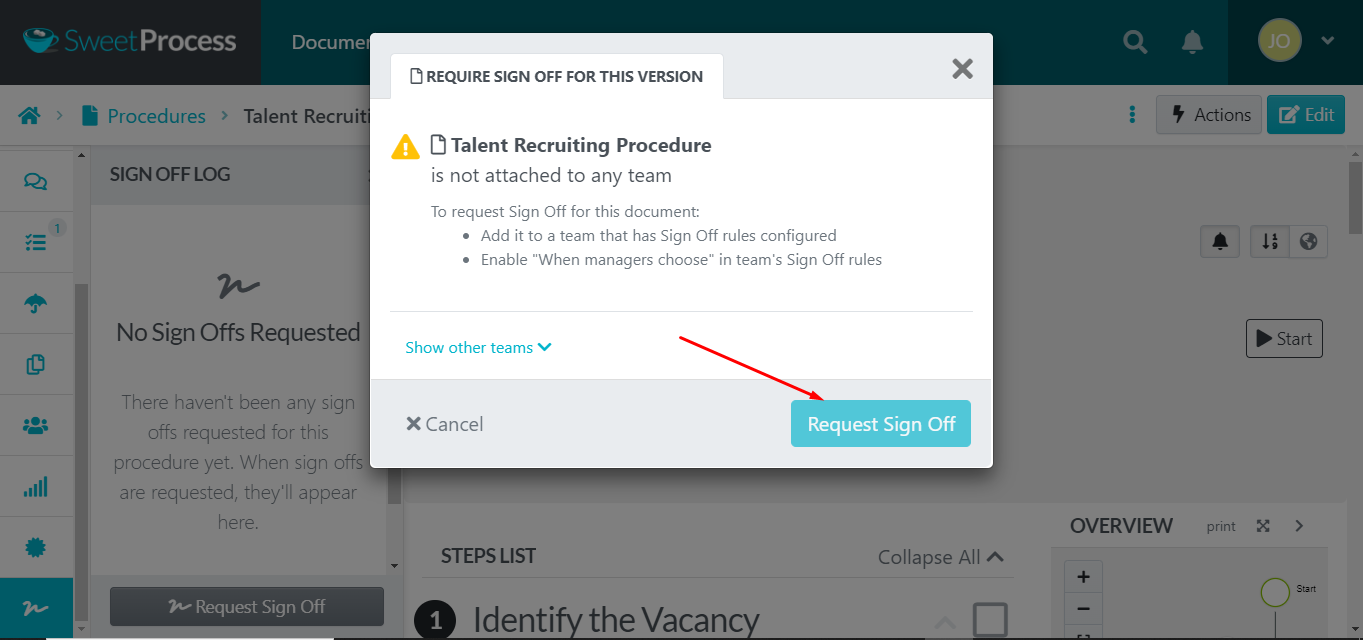
Add Procedure to Your Knowledge Base
Another way to make your SOPs available to all team members is to make them a part of your knowledge base. SweetProcess has a knowledge base feature, and without starting from scratch, you can turn your existing SOP into a knowledge base article. Here’s how:
Open the specific SOP and click on “Actions.”
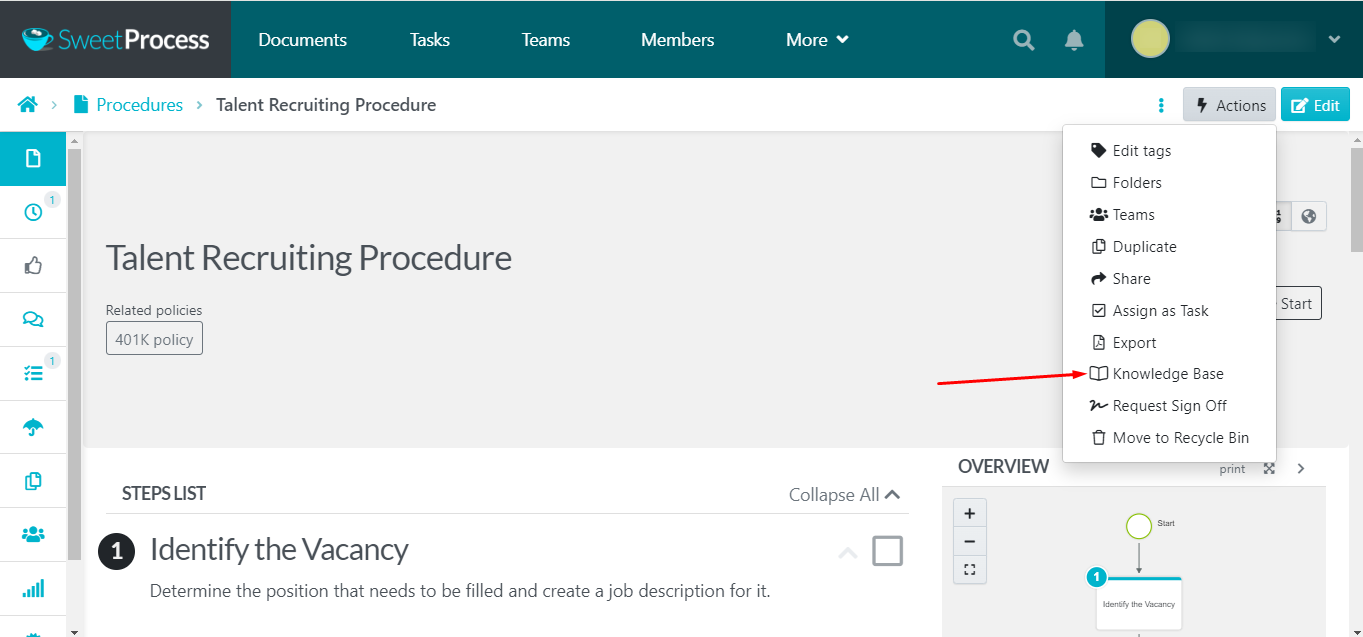
On the dropdown menu, select “Knowledge Base.”

Then, select the category you would like to add to the SOP or create a new category.
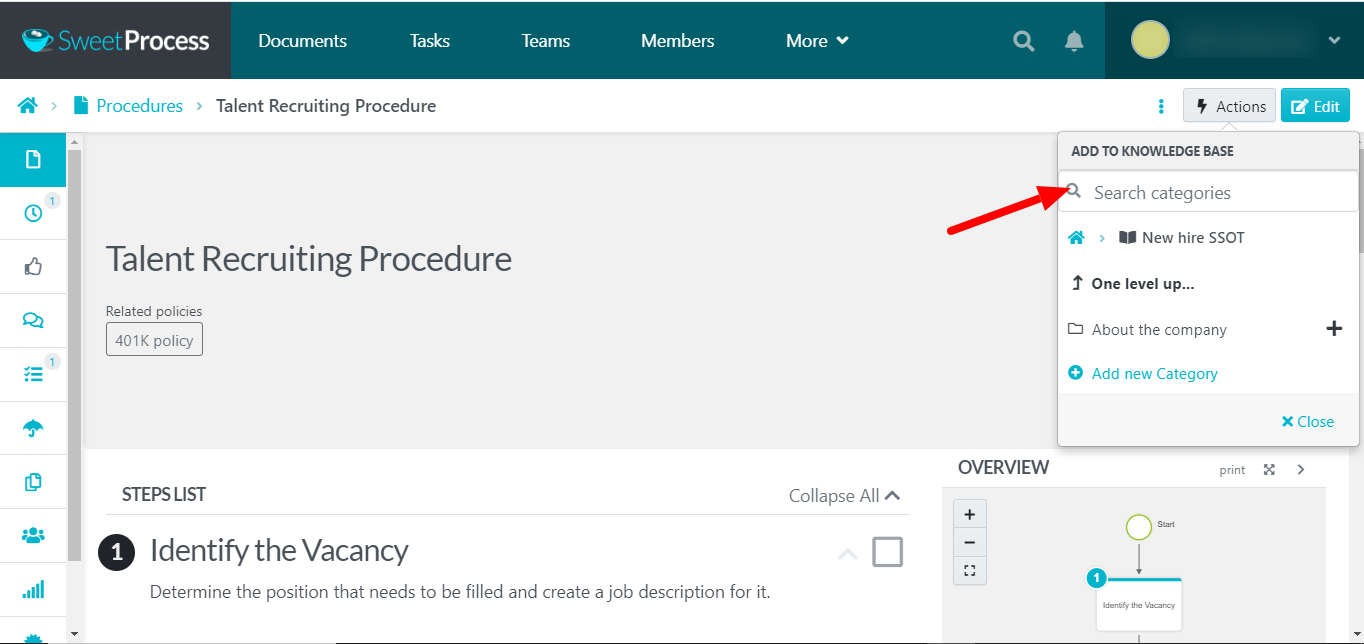
Clicking on the plus (+) sign adds the procedure to your knowledge base.
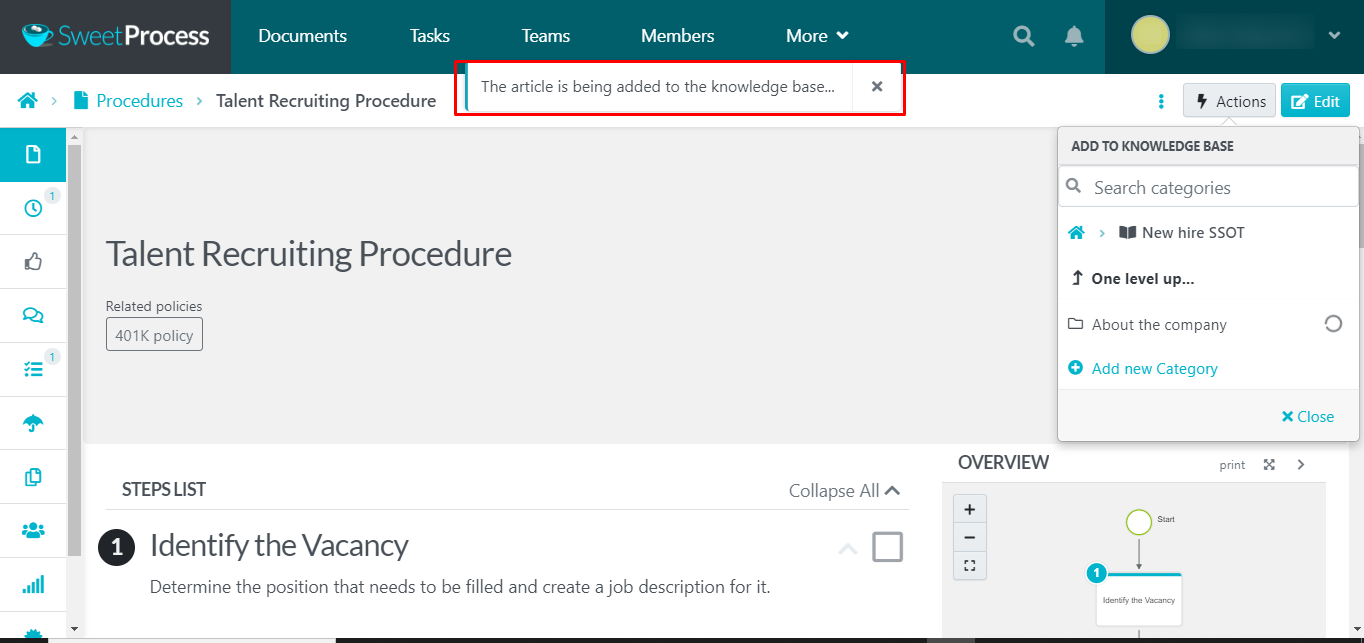
Edit Procedure With AI
You will always need to make edits while reviewing your policies. SweetProcess makes your editing experience sweet. You can either edit the procedure with AI or edit it yourself.
Click on the edit icon.
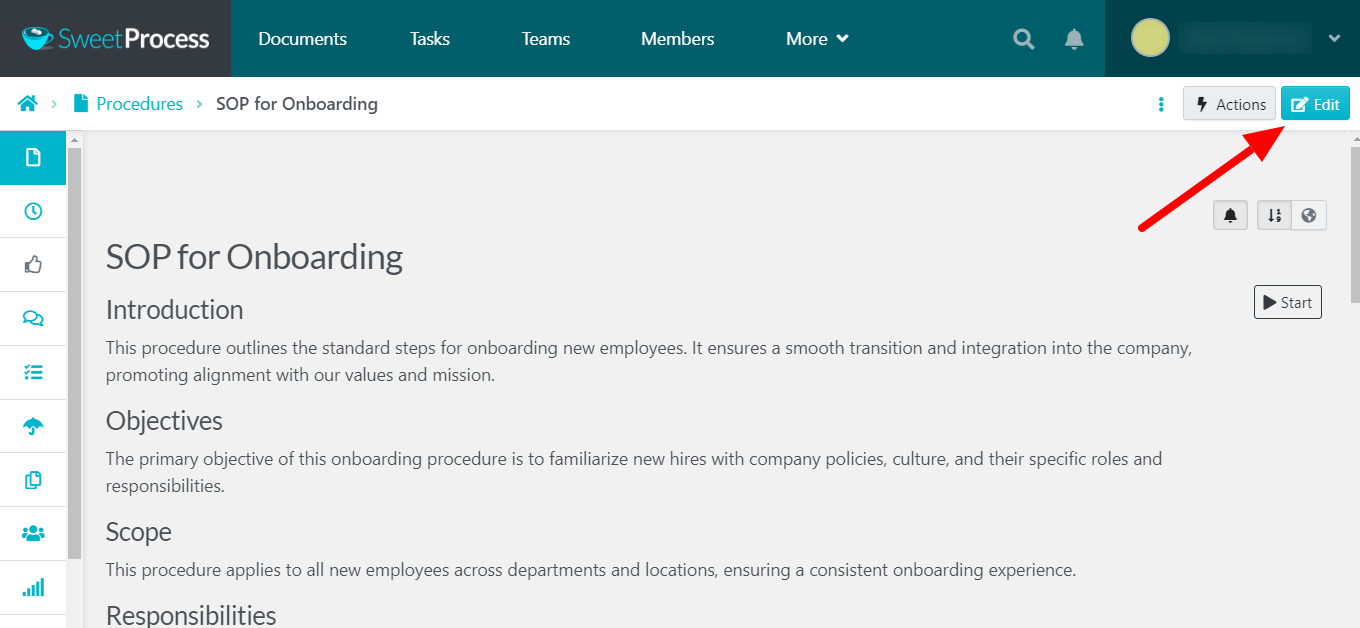
The SweetAI editing interface is displayed for you to input prompts to bring your desired edits.
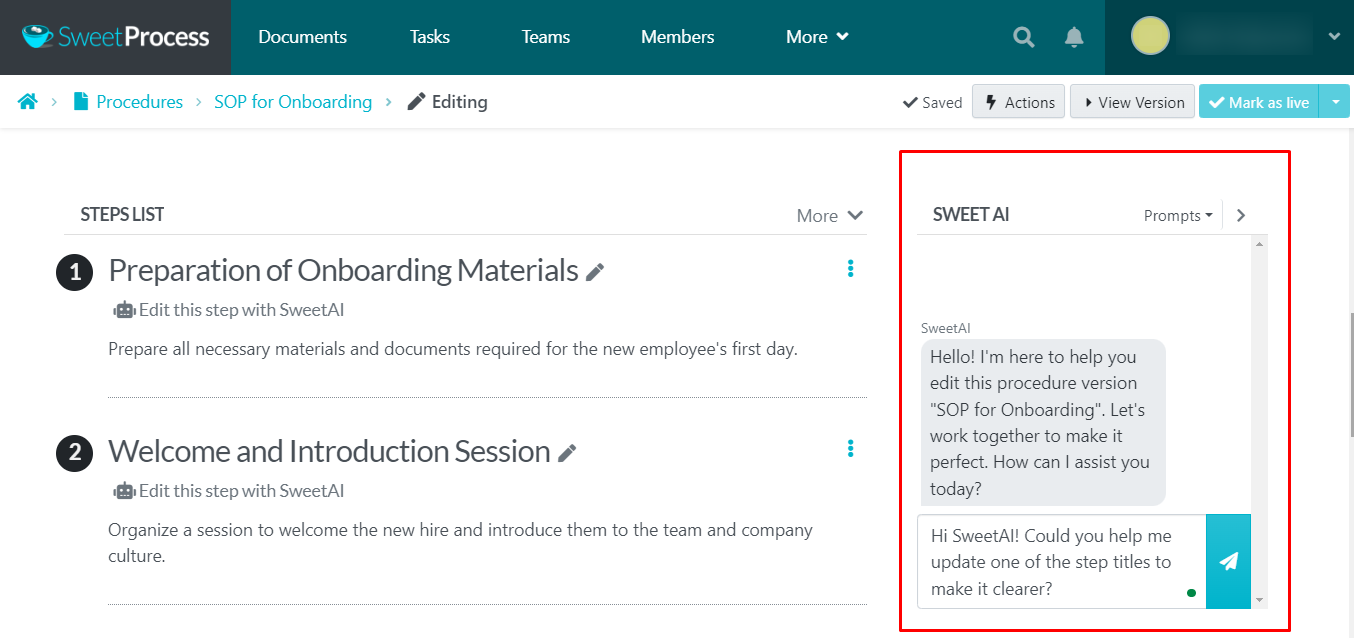
It is common for most companies to have their work instructions and procedures written down, but they need more tools to make the documentation achieve its purpose.
Imagine having your SOPs on Google Drive like Dr. Jeremy Weisz of Rise25. His experience before finding SweetProcess wasn’t palatable. Since the processes were not properly documented, Jeremy was the bottleneck and had to manage everything himself.
When he reached a breaking point, he sought to adopt a tool that would be worth every penny he paid for it. The tool that ended up ticking all the boxes for Jeremy was SweetProcess. The ease and clarity that come with using SweetProcess are better experienced.
According to Jeremy, “When you get in and you start creating these SOPs, it’s very clear. It’s very step-by-step. In a Google Doc, it’s a blank slate. It’s like, I have to add this, stop, and then renumber all the other numbers. It’s just a pain. In SweetProcess, you go in, and you create it. You could see this step-by-step.”
Like most other managers who have yet to standardize their procedures, Austin Maxwell of Maxwell Counters faced a similar dilemma. His team’s procedure documents were flying around in paper binders, Microsoft Word documents, and Google Drive.
There was no way to track who worked with which version, so their processes were not standardized.
After adopting SweetProcess, the team at Maxwell Counters testified that it helped them save a lot of time and energy and made their processes clearer and more consistent.
According to Austin, “The best result has just been consistency, being able to point people toward one website and make sure that they know that’s where they need to go for questions on anything. So it really eliminated a lot of repetitive questioning that really wasn’t adding value.”
Key Components of an SOP: What to Include in a Standard Operating Procedure
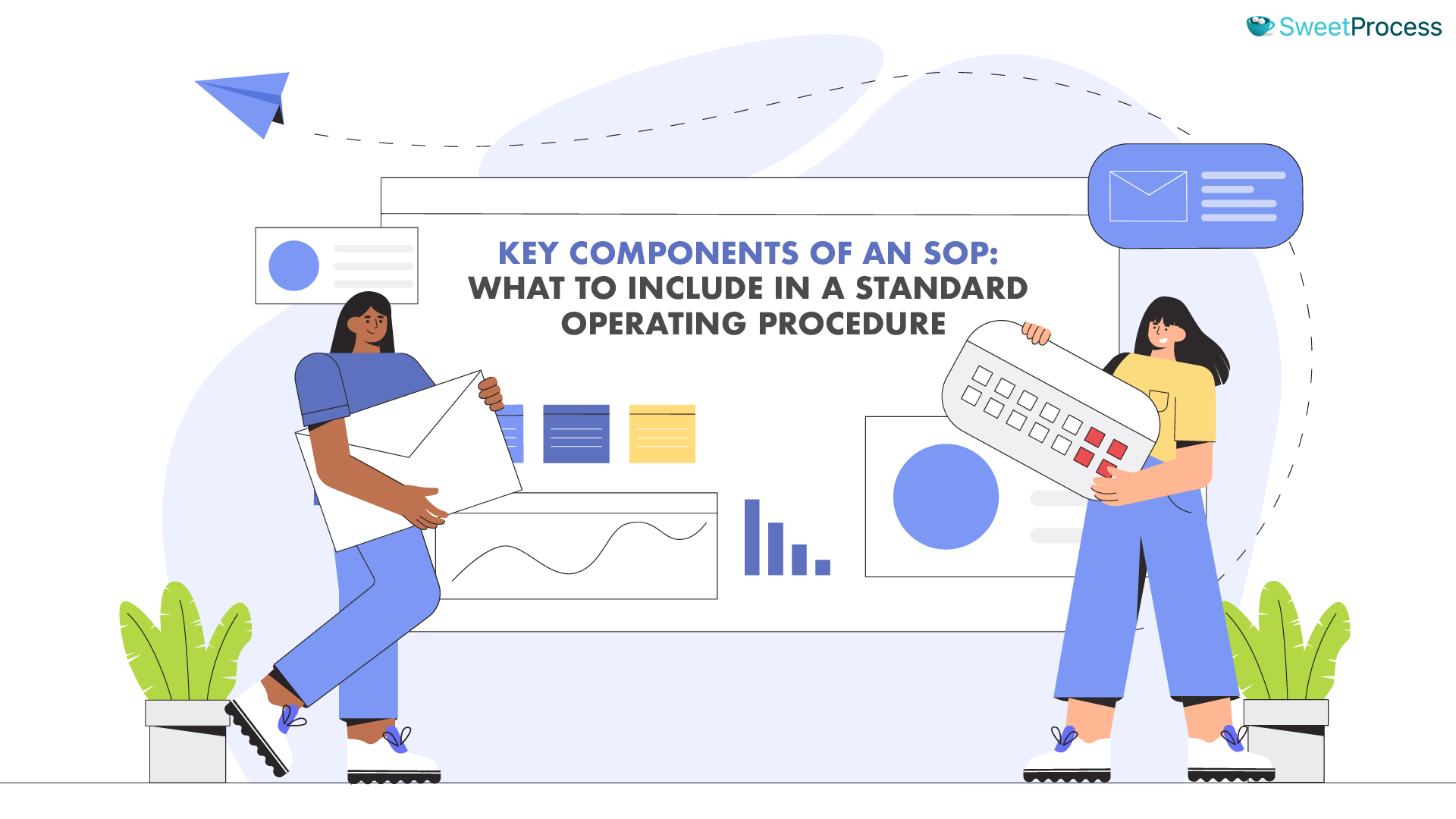
A well-structured SOP should ensure clarity, consistency, and efficiency. Here are the key components every SOP should include:
Document Title
For proper documentation, it is important to start with a clear and concise title that reflects the process or task. You should also include essential details like the document ID, version number, author, and creation date.
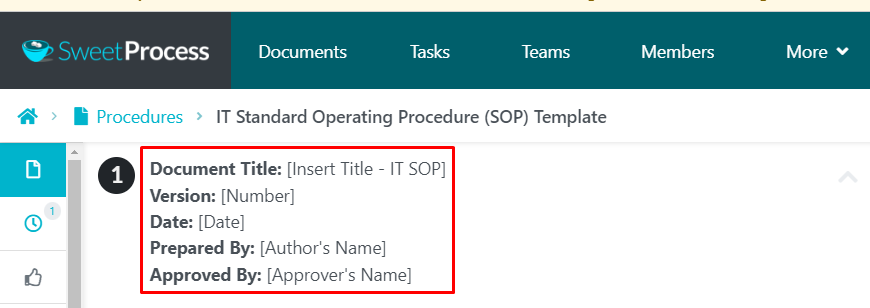
Definitions
Provide a glossary of terms or abbreviations used in the SOP. This section will reduce ambiguity and ensure all users understand the terminologies.
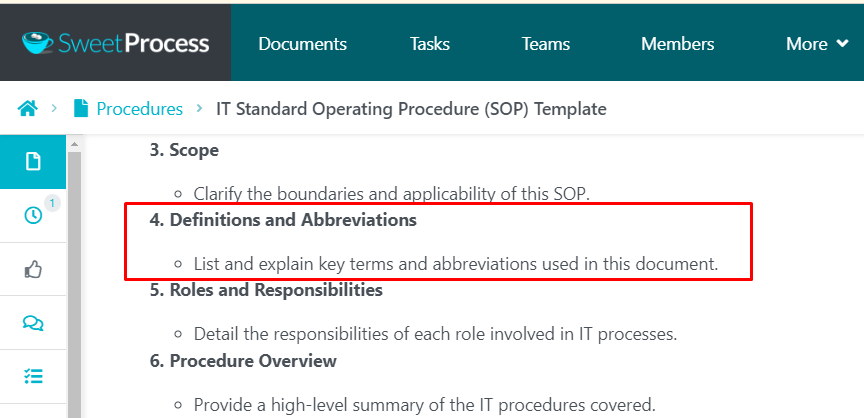
Purpose
Explain why each SOP exists. Your SOP document should highlight the specific problem it addresses, the goals it aims to achieve, and its overall importance to the organization.
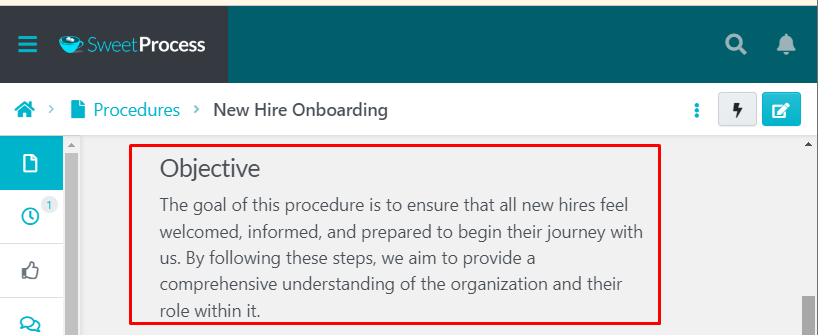
Scope
Define the boundaries of the SOP. What tasks, roles, or departments does it cover? This section prevents overlap with other documents and gives it a clear focus.
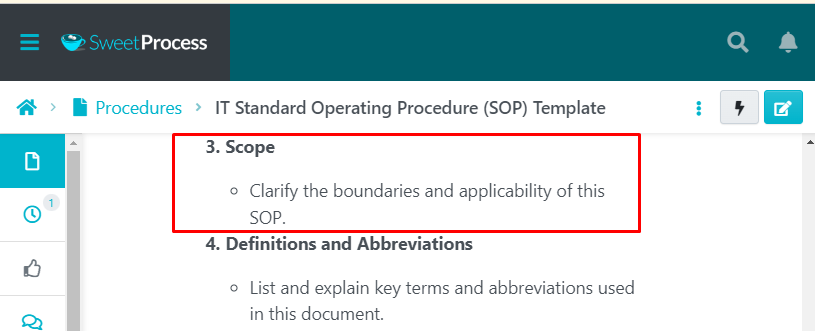
Procedures
This is the heart of the SOP. List step-by-step instructions to complete the specific task or process. Use numbered lists, diagrams, or flowcharts for better readability and clarity.
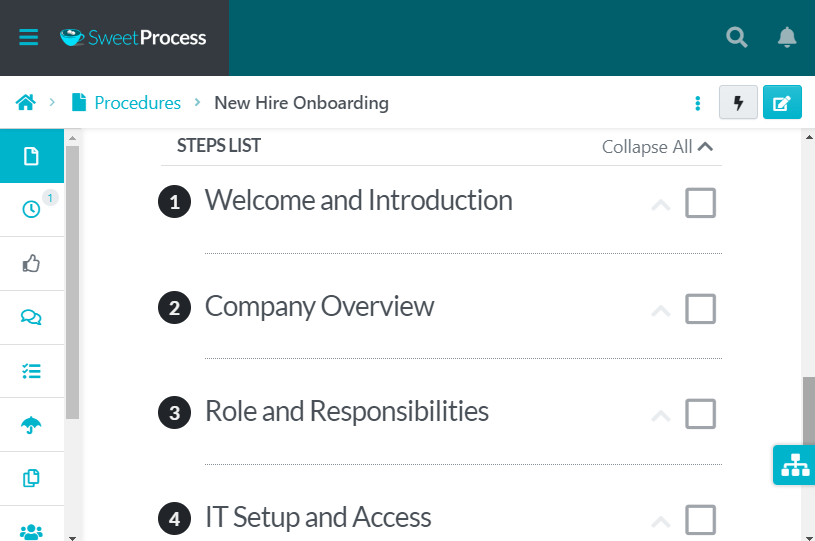
Responsibilities
Clarify who is responsible for each step of the procedure. Assign roles to specific individuals or teams to ensure accountability and smooth execution.

Materials and Equipment
List all tools, equipment, or materials required to perform the procedure. Providing this information upfront allows for adequate preparation before starting the task.
References
Include links or citations to relevant policies, guidelines, or any supporting documents. This helps users access additional context or information when needed.
Approval and Revision History
For documentation, you should track the SOP and its revision history. This section ensures the document is up-to-date and properly vetted for accuracy and compliance.
Including these components will make your SOP serve as a comprehensive guide and make complex tasks easy to understand and execute.
5 SOP Examples to Inspire Your Team

Looking for inspiration to create standard operating procedures (SOPs) that truly make a difference? Here are five impactful examples to guide your team and streamline your operations:
SOP for New Hires
The new hire SOP outlines the step-by-step process for welcoming and integrating new employees into your organization. It typically covers documentation, account setup, introductions, and an overview of company policies. The new hire SOP should ensure a smooth and professional start for every new team member.
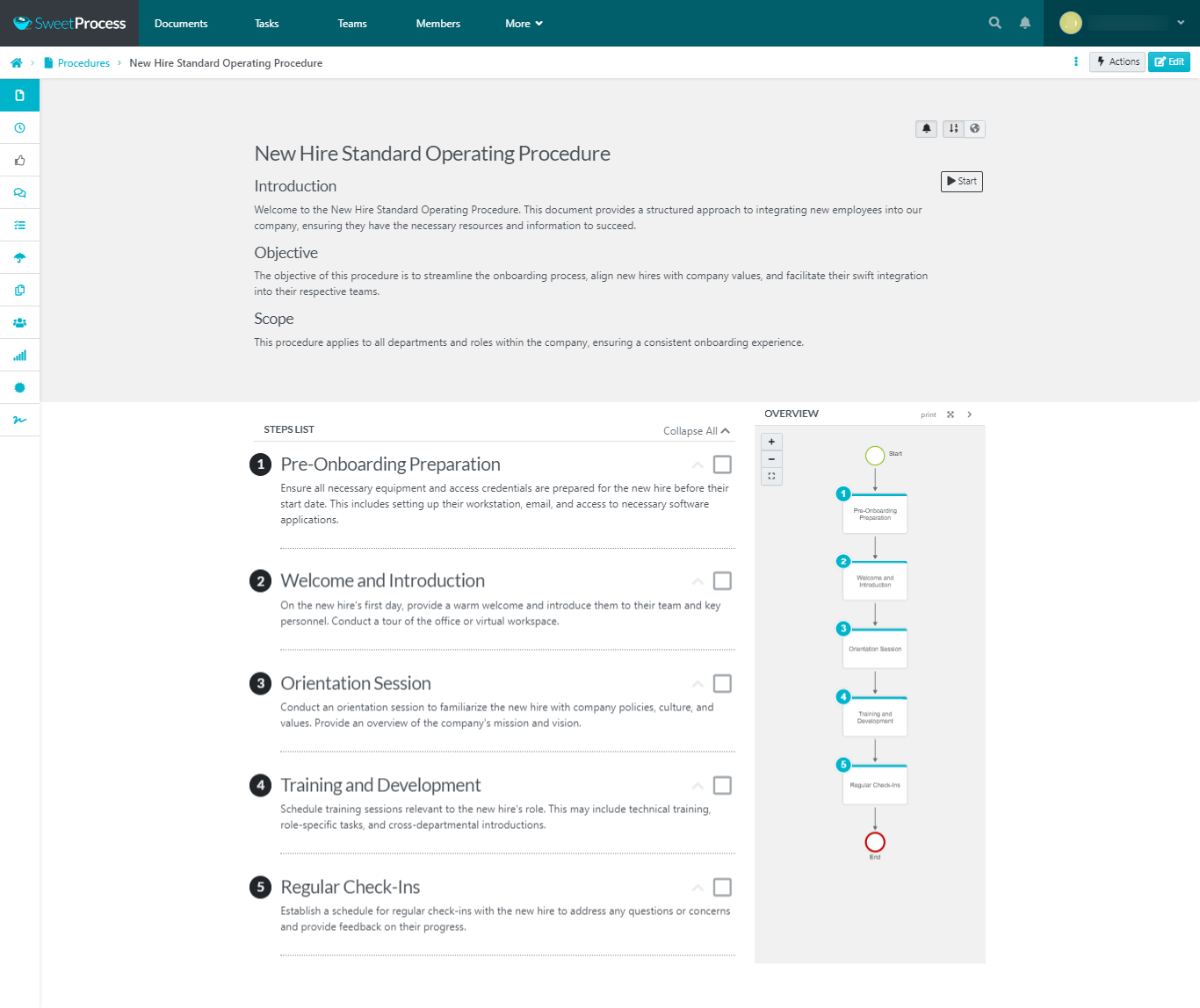
Download the SOP for new hires
SOP for Office Administration
Office administration SOPs detail daily tasks like managing schedules, organizing files, handling correspondence, and maintaining office supplies. These procedures keep the workplace running efficiently and ensure that no critical administrative duties are overlooked.
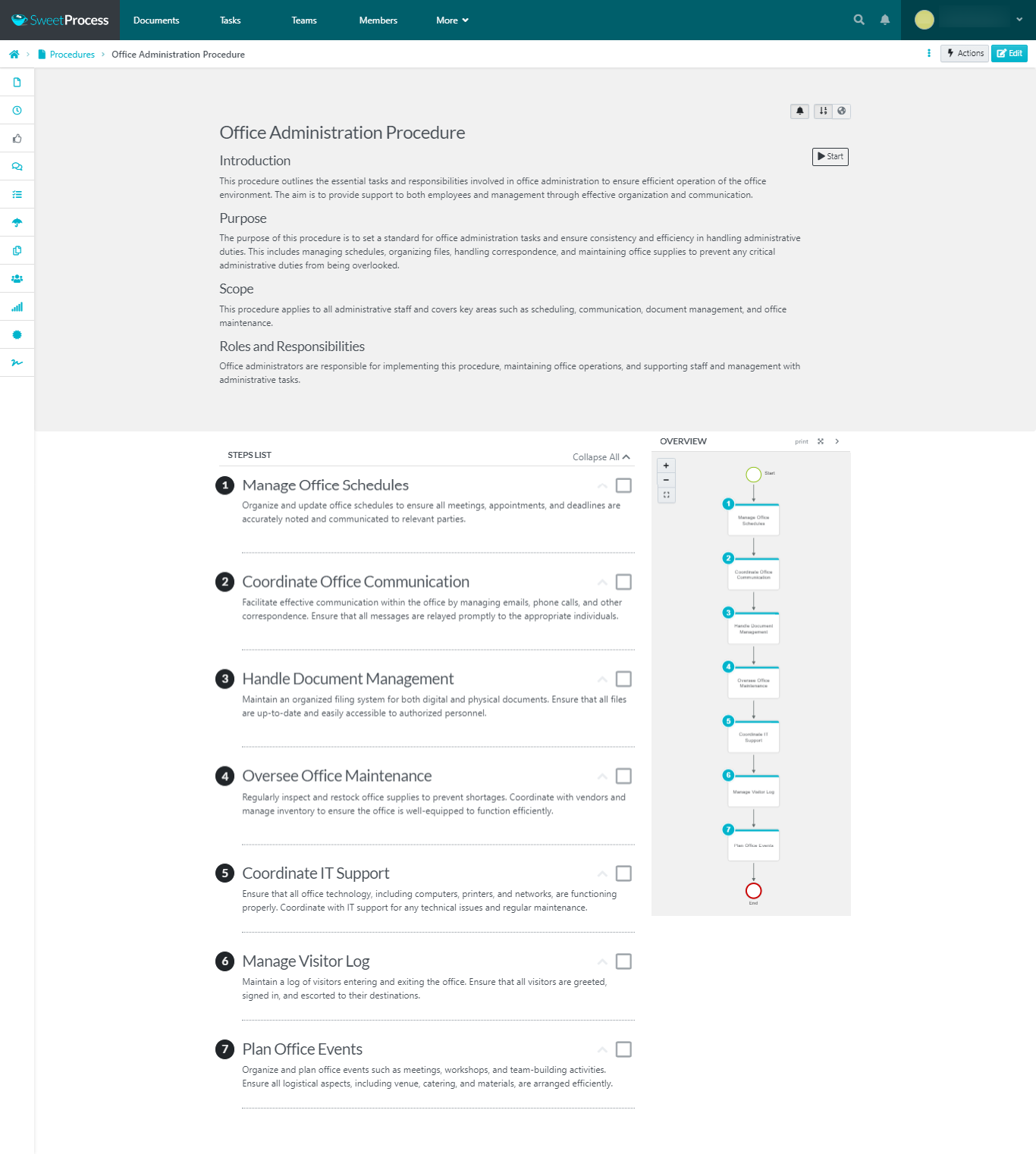
Download the SOP for office administration
SOP for Onboarding
The onboarding SOP is different from the new hire SOP. It dives deeper into training plans, mentoring schedules, and team integration. It helps to set clear expectations for new employees while showing them how to adapt to their roles and company culture.
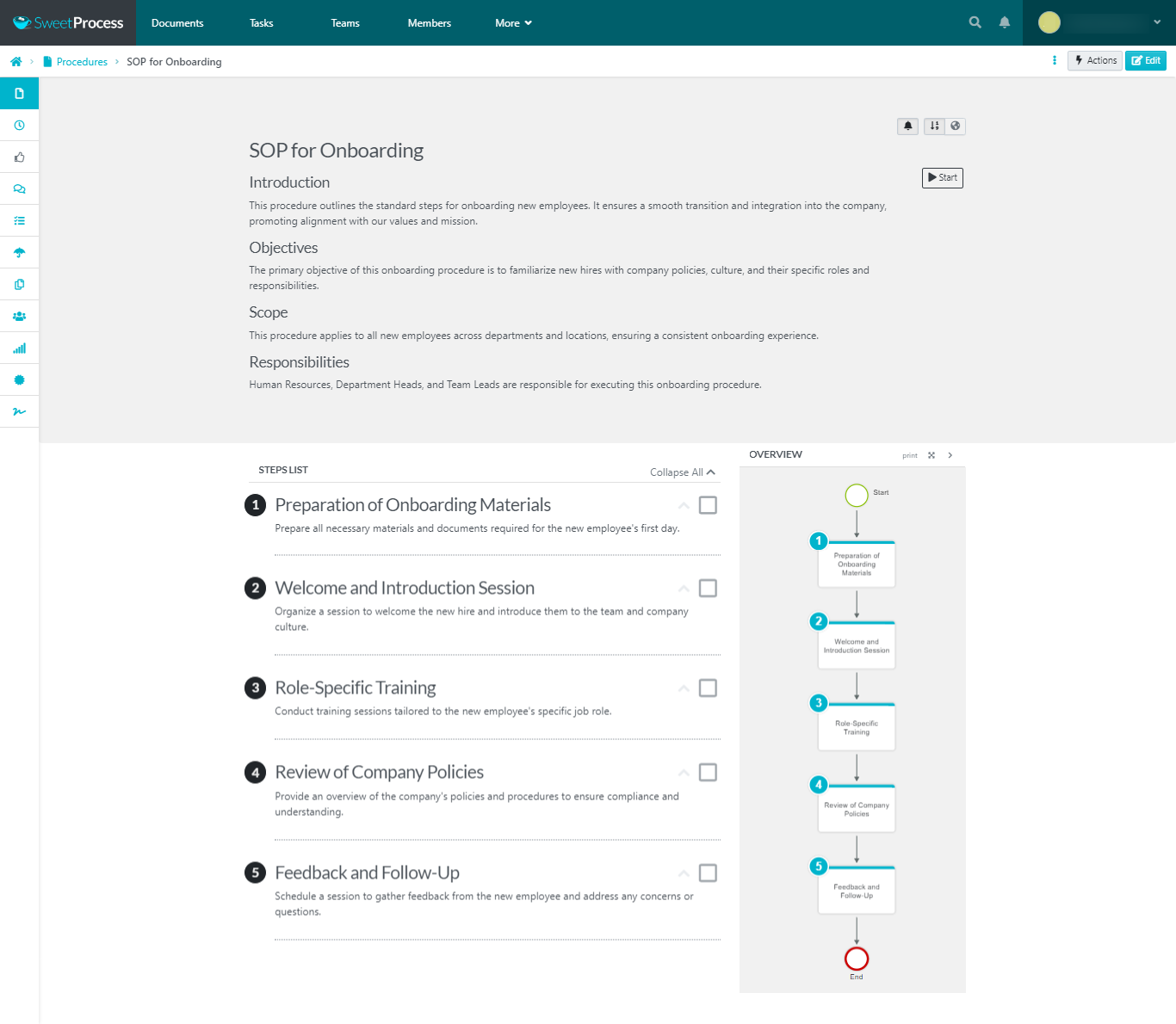
Download the SOP for onboarding
SOP for Client Management
This SOP helps standardize client interactions, including initial contact, ongoing communication, and issue resolution. It shows guidelines for the intake process, handling inquiries, preparing proposals, conducting meetings, and following up. A robust client management SOP enhances professionalism and builds strong relationships.
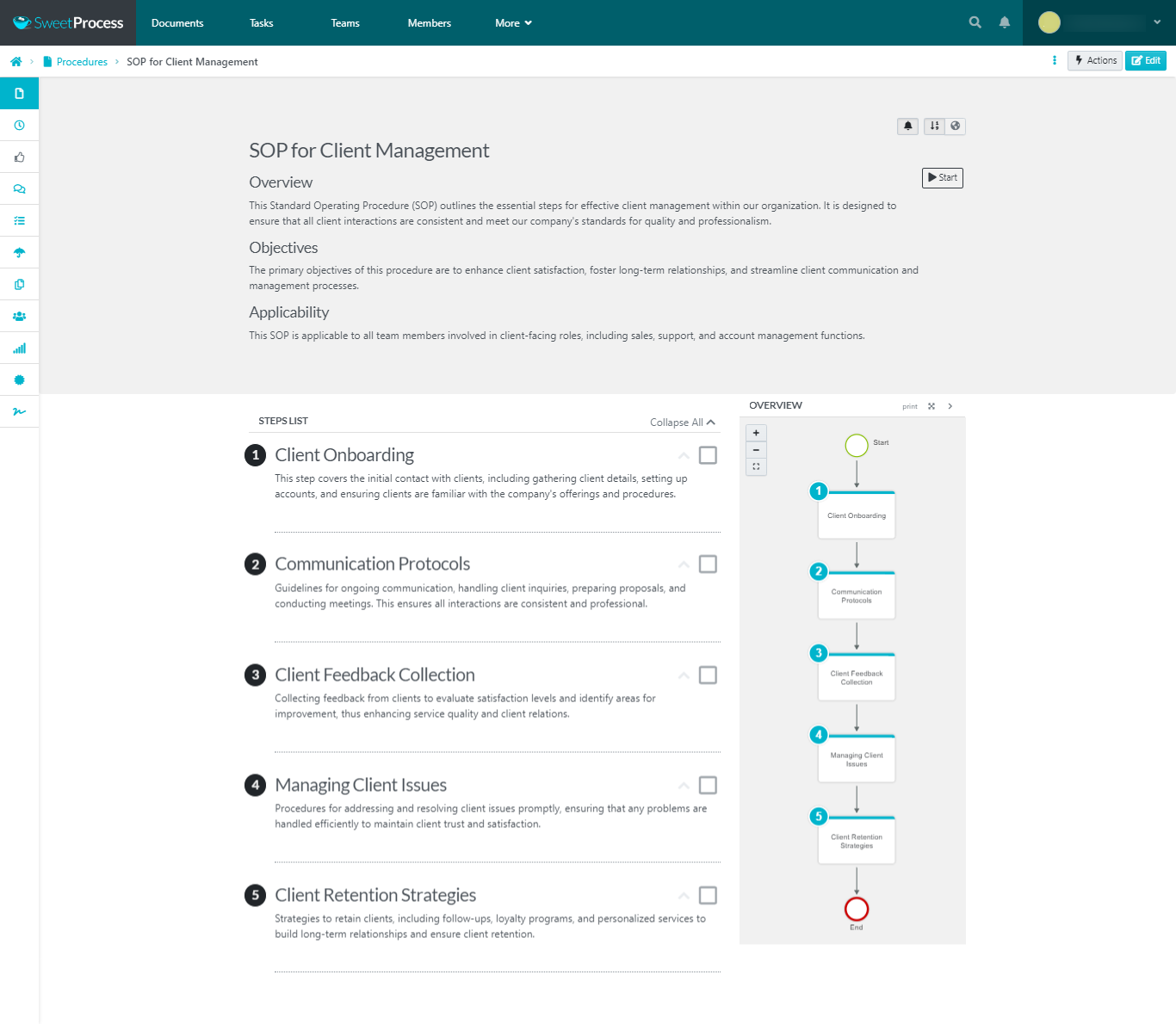
Download the SOP for client management
SOP for Environmental Health and Safety
It is designed for industries where safety is paramount. Environmental health and safety procedures ensure compliance with regulations and promote a safe work environment. It covers hazard assessment, risk mitigation, emergency protocols, and routine safety checks.
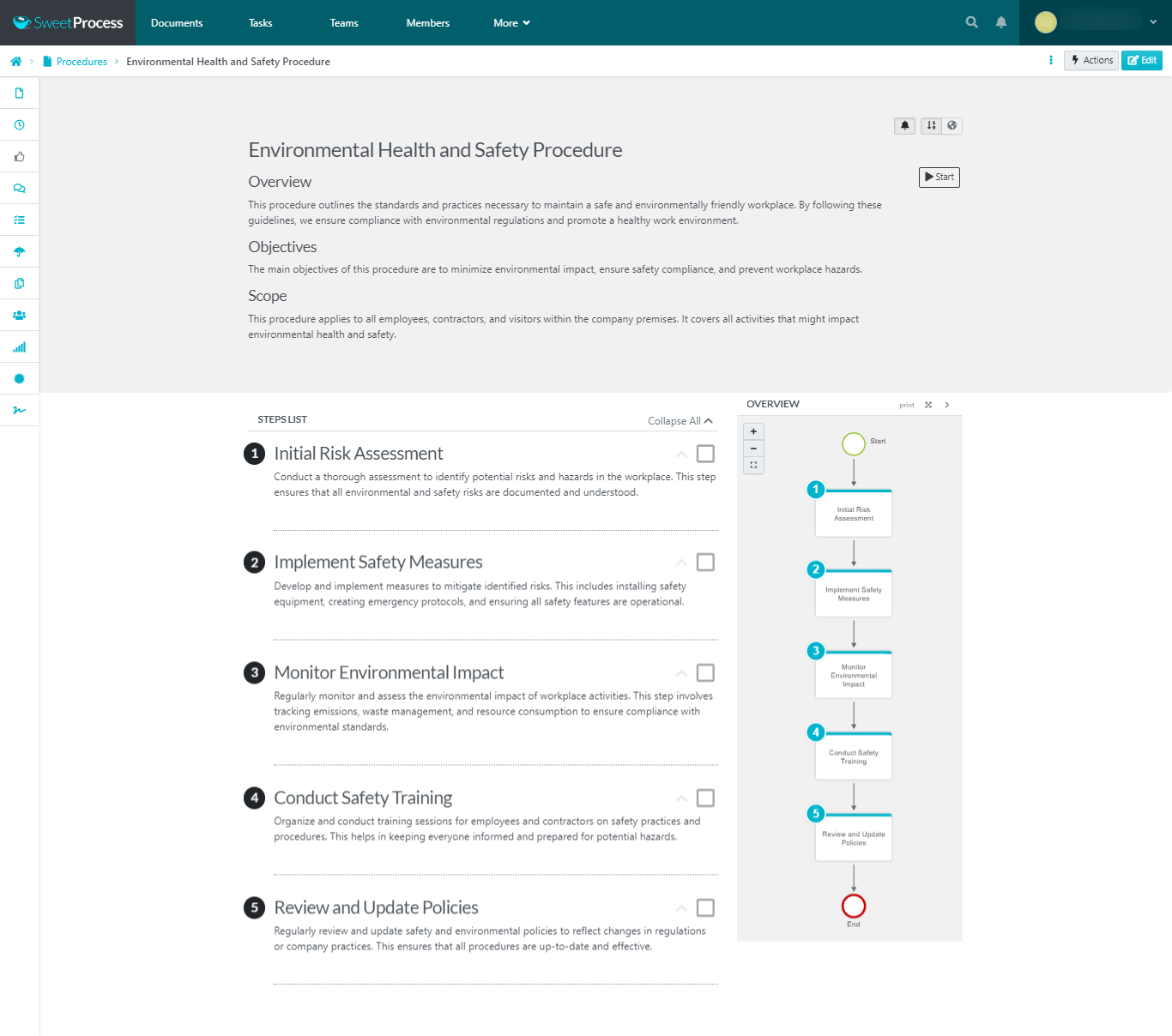
Download the SOP for environmental health and safety
The above SOP examples showcase how structured processes can improve efficiency, ensure regulatory compliance, and foster a productive workplace. Feel free to use them as a foundation to create SOPs tailored to your team’s unique needs.
If you have your procedures in Word, Docs, or PDF format, you can import them to SweetProcess in a few minutes.
Standard Operating Procedure Formats and Types
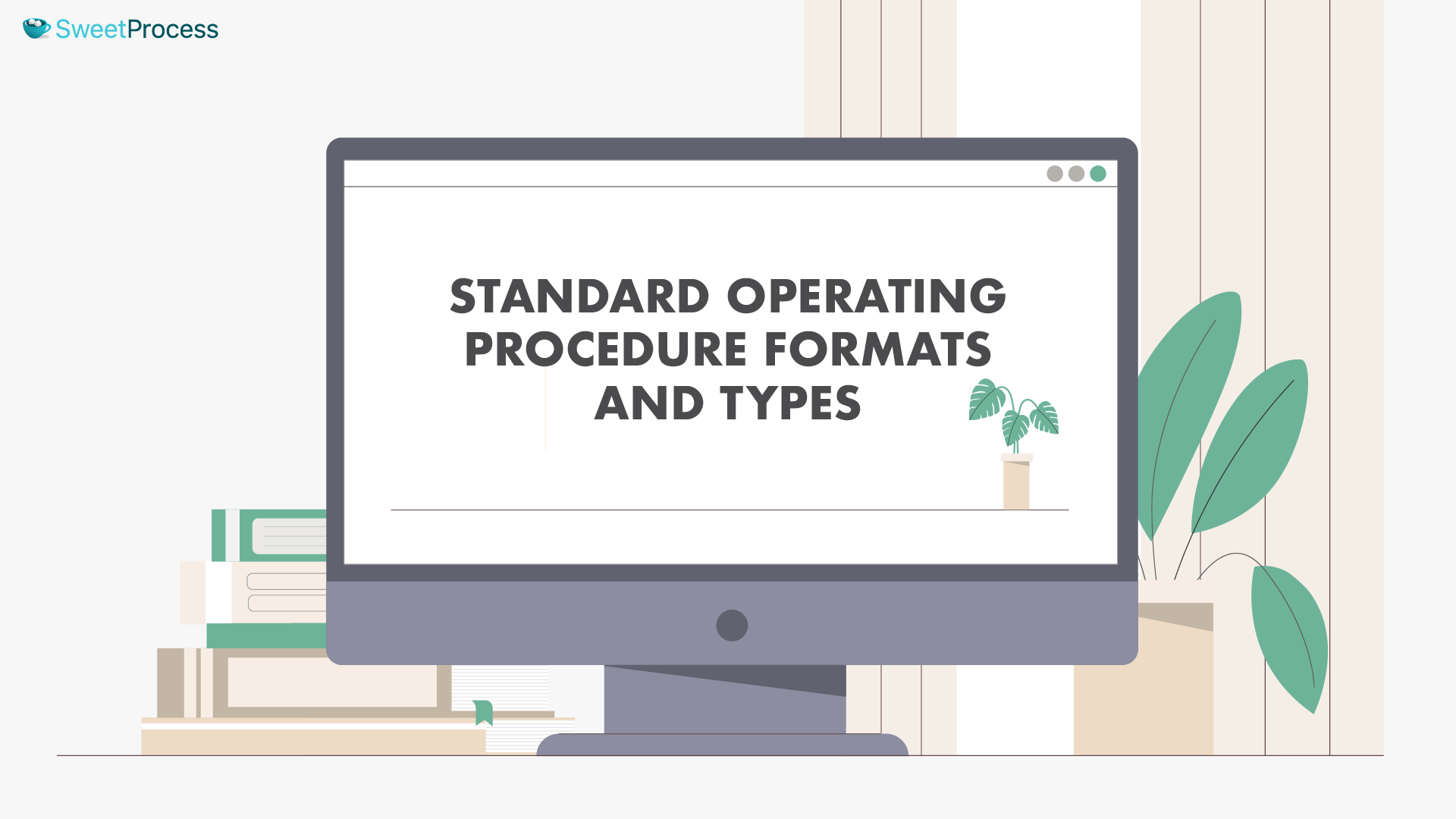
SOPs can come in different formats. Even though the most common one is the text-based SOP, other formats, like video format, can also be used depending on the complexity of the task, the audience, and how the information will be used. Here are some common SOP formats and types to consider:
Text-Based SOP
This is the most traditional SOP format, usually with clear, written instructions. It’s ideal for detailed, step-by-step guidance on processes or tasks. Text-based SOPs are easy to share, edit, and update, making them popular for many organizations.
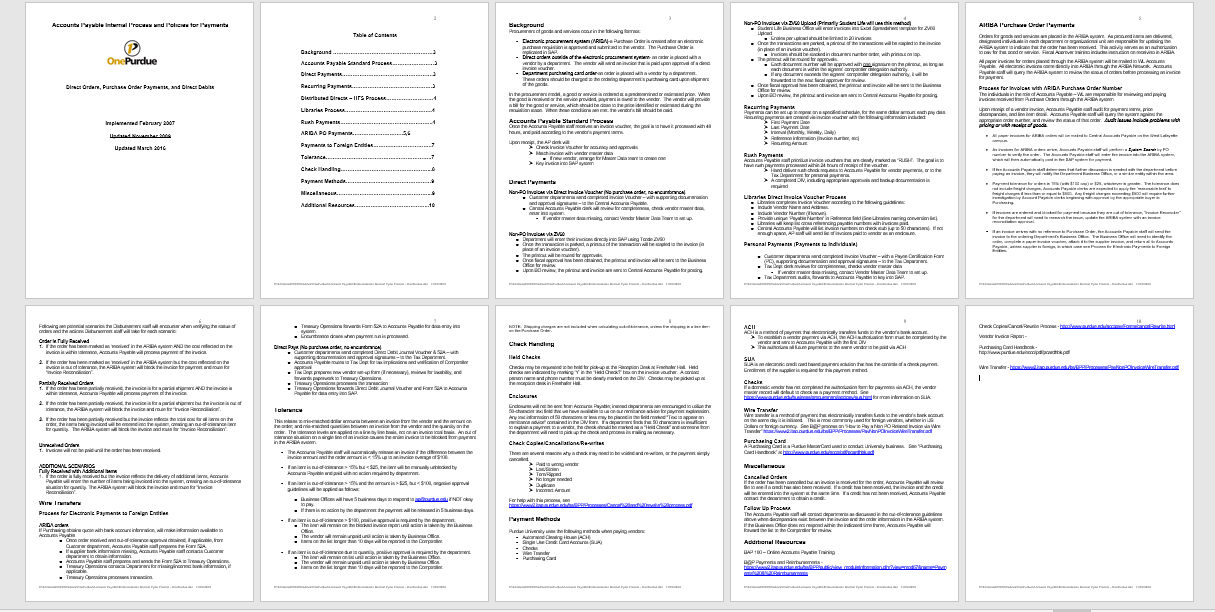
A text-based SOP example
Video-Based SOP
Video SOPs combine visual and auditory elements to guide users through a process. These SOPs are particularly useful for tasks that involve complex operations, such as machinery use or detailed software navigation. Video-based SOPs can be more engaging and help ensure proper understanding through demonstration.
An example of a company that uses a lot of video SOPs is Chipotle, and here’s an example of their ordering process SOP video:
(An example of video-based SOP)
Hierarchical SOP
In a hierarchical SOP, information is structured top-down, with broader categories or steps listed first, followed by more detailed and clear instructions. This format is ideal for processes that require multiple levels of decision-making or stages of action, helping users follow a logical, organized progression.
An example is McDonald’s Hierarchical SOP for the preparation of the Big Mac shown below:
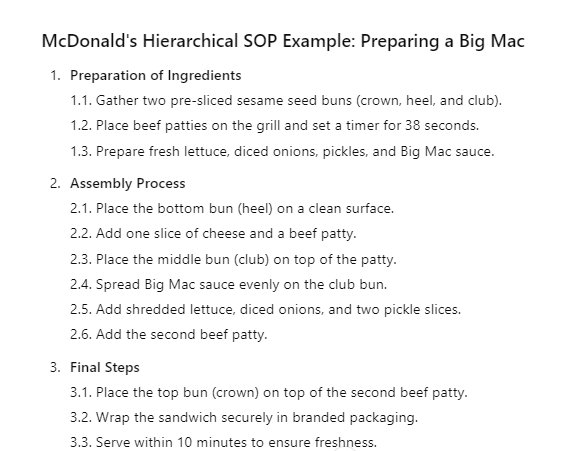
McDonalds’ Inspired Hierarchical SOP
Checklist SOP
A checklist SOP provides a simple, bulleted list of tasks or steps to be completed. It’s particularly effective for straightforward procedures where a user must complete each step sequentially. This format is highly actionable and useful for routine tasks or audits.
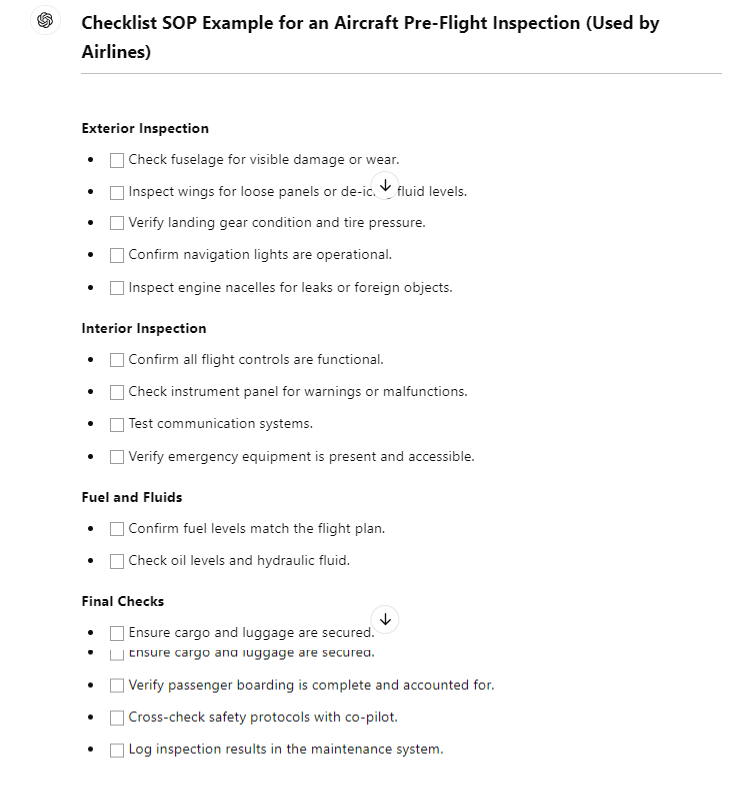
Sample checklist SOP for preflight inspection
Hybrid SOP
A hybrid SOP combines elements of multiple formats, such as a text-based SOP with checklists or video inserts. This format is ideal for complex processes where both detailed instructions and visual aids (like charts or diagrams) are needed to enhance understanding and effectiveness.
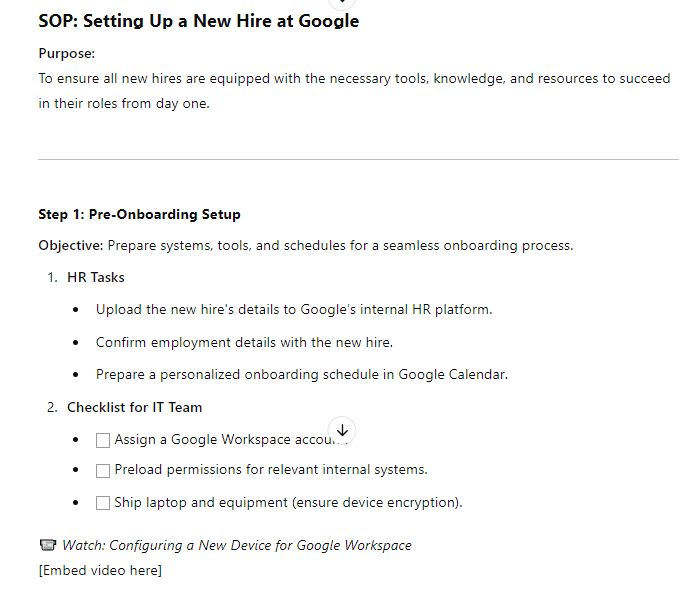
Google-inspired blended SOP for new hire onboarding
Each SOP format serves a unique purpose, so selecting the right type for your process is a good way to ensure efficiency, clarity, and user engagement.
Manage Your Business Operations Like a Pro Using SweetProcess
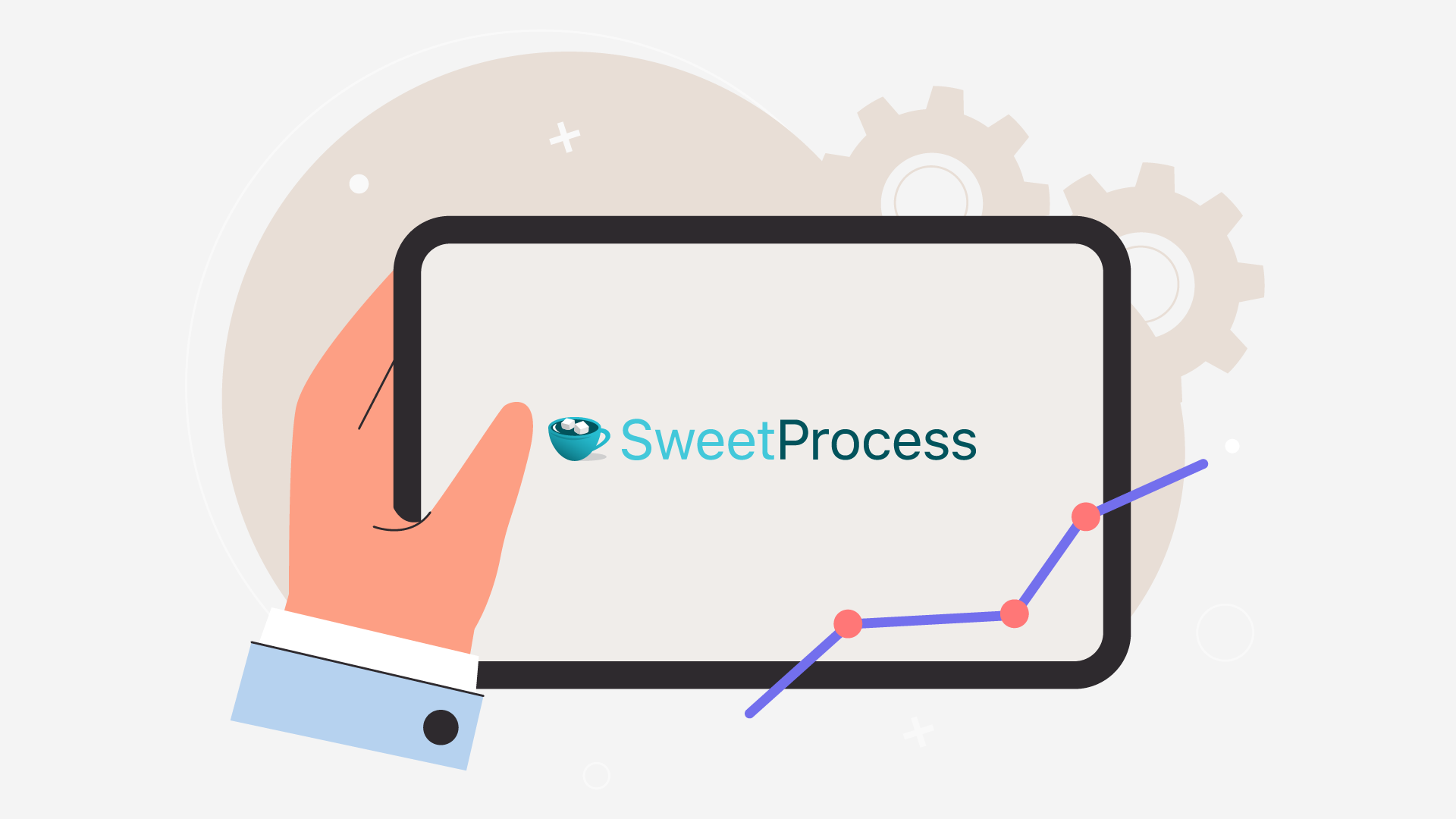
Whether you’re looking for ideas or creating your first SOP, this post will provide the support you need.
The 13 SOP templates, the five SOP examples, and the five SOP formats will equip you to create any type of SOP to manage your team and processes.
Sometimes, having the skill is less important than having the right tool. This is why we recommend signing up for a free SweetProcess account.
For small and mid-sized companies looking for affordable and easy-to-use SOP software, SweetProcess could be the right choice.
